Techno-Economic-Environmental Assessment of an Isolated Rural Micro-Grid from a Mid-Career Repowering Perspective
Abstract
1. Introduction
- Indigenous resource assessments
- Isolated microgrid design and optimization for rural areas
- Multi-dimensional (techno-economic-environmental) analysis
- Small-scale measures for a certain percentage of carbon neutrality
- Mid-career repowering across future requirements
- Cases and scenarios considering variables like seasonal variations
2. Methodology
2.1. Site Selection
2.2. Load Calculation
| No. of Houses | Lights (Wh) | Fans (Wh) | TV (Wh) | Refrigerator (Wh) | Water Pump (Wh) | Phone Charger (Wh) | Load in Summer (kWh/day) | Load in Winter (kWh/day) |
|---|---|---|---|---|---|---|---|---|
| 1 | 4 × 20 × 14 = 1120 | 2 × 75 × 12 = 1800 | 1 × 120 × 3 = 360 | NA | 1 × 1200 × 0.5 = 600 | 1 × 8 × 2 = 16 | 3.896 | 2.096 |
| 2 | 3 × 20 × 12 = 720 | 2 × 75 × 11 = 1650 | NA | NA | 1 × 1200 × 0.5 = 600 | 1 × 8 × 2 = 16 | 2.986 | 1.336 |
| 3 | 4 × 20 × 10 = 800 | 2 × 75 × 12 = 1800 | 1 × 120 × 2 = 240 | NA | 1 × 1200 × 0.5 = 600 | 1 × 8 × 2 = 16 | 3.456 | 1.656 |
| 4 | 4 × 20 × 12 = 960 | 2 × 75 × 10 = 1500 | 1 × 120 × 2 = 240 | NA | 1 × 1200 × 0.5 = 600 | 1 × 8 × 2 = 16 | 3.316 | 1.816 |
5 | 5 × 20 × 13 = 1300 | 2 × 75 × 12 = 1800 | 1 × 120 × 3 = 360 | NA | 1 × 1200 × 0.25 = 300 | 1 × 8 × 2 = 16 | 3.776 | 1.976 |
| 6 | 4 × 20 × 10 = 800 | 2 × 75 × 8 = 1200 | 1 × 120 × 2 = 240 | NA | 1 × 1200 × 0.25 = 300 | 1 × 8 × 2 = 16 | 2.556 | 1.356 |
| 7 | 4 × 20 × 8 = 640 | 2 × 75 × 10 = 1500 | 1 × 120 × 3 = 360 | 1 × 240 × 16 = 3840 | 1 × 1200 × 0.25 = 300 | 1 × 8 × 2 = 16 | 6.676 | 5.176 |
| 8 | 4 × 20 × 9= 720 | 2 × 75 × 8 = 1200 | 1 × 120 × 3 = 360 | 1 × 240 × 14 = 3360 | 1 × 1200 × 0.25 = 300 | 2 × 8 × 2 = 32 | 5.972 | 4.772 |
| 9 | 8 × 20 × 8 = 1280 | 4 × 75 × 8 = 2400 | 1 × 120 × 3= 360 | 1 × 240 × 16 = 3840 | 1 × 1200 × 0.5 = 600 | 2 × 8 × 2 = 32 | 8.512 | 6.112 |
| 10 | 14 × 20 × 5 = 1400 | 10 × 75 × 4 = 3000 | NA | NA | 1 × 1200 × 0.6 = 720 | NA | 5.0 | 2.0 |
| Load in Summer | Load in Winter | |||||||
|
| |||||||
| For the community of 150 houses, annual mean load = (923 + 566)/2 = 1489 kWh/day | ||||||||
| No. of Houses | Lights (Wh) | Fans (Wh) | TV (Wh) | Refrigerator (Wh) | Water Pump (Wh) | Phone Charger (Wh) | Load in Summer (kWh/day) | Load in Winter (kWh/day) |
|---|---|---|---|---|---|---|---|---|
| 1 | 4 × 15 × 9 = 540 | 2 × 80 × 12 = 1920 | 1 × 80 × 4 = 320 | 1 × 250 × 12 = 3000 | 1 × 1200 × 0.5 = 600 | 1 × 8 × 2 = 16 | 3.896 | 2.096 |
| 2 | 4 × 20 × 12 = 960 | 2 × 75 × 11 = 1650 | NA | NA | 1 × 1200 × 0.75 = 900 | 1 × 8 × 2 = 16 | 3.526 | 1.876 |
| 3 | 4 × 20 × 10 = 800 | 2 × 75 × 12 = 1800 | 1 × 120 × 2 = 240 | NA | 1 × 1200 × 0.5 = 600 | 1 × 8 × 2 = 16 | 3.456 | 1.656 |
| 4 | 4 × 20 × 12 = 960 | 2 × 75 × 10 = 1500 | 1 × 120 × 2 = 240 | NA | 1 × 1200 × 0.5 = 600 | 1 × 8 × 2 = 16 | 3.316 | 1.816 |
| 5 | 6 × 20 × 13 = 1560 | 2 × 75 × 12 = 1800 | 1 × 120 × 3 = 360 | NA | 1 × 1200 × 0.25 = 300 | 1 × 8 × 2 = 16 | 4.036 | 2.236 |
| 6 | 4 × 20 × 10 = 800 | 2 × 75 × 8 = 1200 | 1 × 120 × 2 = 240 | NA | 1 × 1200 × 0.25 = 300 | 1 × 8 × 2 = 16 | 2.556 | 1.356 |
| 7 | 4 × 20 × 8 = 640 | 2 × 75 × 10 = 1500 | 1 × 120 × 3 = 360 | 1 × 240 × 16 = 3840 | 1 × 1200 × 0.25 = 300 | 1 × 8 × 2 = 16 | 6.676 | 5.176 |
| 8 | 4 × 20 × 9 = 720 | 2 × 75 × 8 = 1200 | 1 × 120 × 3 = 360 | 1 × 240 × 14 = 3360 | 1 × 1200 × 0.25 = 300 | 2 × 8 × 2 = 32 | 5.972 | 4.772 |
| 9 | 8 × 20 × 8 = 1280 | 4 × 75 × 8 = 2400 | 1 × 120 × 3 = 360 | 1 × 240 × 16 = 3840 | 1 × 1200 × 0.5 = 600 | 2 × 8 × 2 = 32 | 8.512 | 6.112 |
| 10 | 16 × 20 × 5 = 1600 | 10 × 75 × 4 = 3000 | NA | NA | 1 × 1200 × 0.75 = 900 | NA | 5.5 | 2.5 |
| Load in Summer | Load in Winter | |||||||
|
| |||||||
| For the community of 150 houses, annually mean load = (711.69 + 444)/2 = 577.845 kWh/day | ||||||||
| No. of Houses | Lights (Wh) | Fans (Wh) | TV (Wh) | Refrigerator (Wh) | Water Pump (Wh) | Phone Charger (Wh) | Load in Summer (kWh/day) | Load in Winter (kWh/day) |
|---|---|---|---|---|---|---|---|---|
| 1 | 5 × 20 × 8 = 800 | 3 × 75 × 8 = 1800 | 1 × 120 × 3 = 360 | NA | 1 × 1200 × 0.5 = 600 | 1 × 8 × 2 = 16 | 3.576 | 1.776 |
| 2 | 4 × 20 × 8 = 640 | 2 × 75 × 10 = 1500 | 1 × 120 × 3 = 360 | 1 × 240 × 16 = 3840 | 1 × 1200 × 0.25 = 300 | 1 × 8 × 2 = 16 | 6.676 | 5.176 |
| 3 | 4 × 20 × 9 = 720 | 2 × 75 × 8 = 1200 | 1 × 120 × 3 = 360 | 1 × 240 × 14 = 3360 | 1 × 1200 × 0.25 = 300 | 2 × 8 × 2 = 32 | 5.972 | 4.772 |
| 4 | 8 × 20 × 8 = 1280 | 4 × 75 × 8 = 2400 | 1 × 120 × 3 = 360 | 1 × 240 × 16 = 3840 | 1 × 1200 × 0.5 = 600 | 2 × 8 × 2 = 32 | 8.512 | 6.112 |
| 5 | 15 × 20 × 5 = 1500 | 10 × 75 × 4 = 3000 | NA | NA | 1 × 1200 × 0.75 = 900 | NA | 5.4 | 2.4 |
| Load in Summer | Load in Winter | |||||||
|
| |||||||
| For the community of 200 houses, annual mean load = (1205.44 + 810)/2 = 1007.72 kWh/day | ||||||||
| No. of Houses | Lights (Wh) | Fans (Wh) | TV (Wh) | Refrigerator (Wh) | Water Pump (Wh) | Phone Charger (Wh) | Load in Summer (kWh/day) | Load in Winter (kWh/day) |
|---|---|---|---|---|---|---|---|---|
| 1 | 4 × 20 × 14 = 1120 | 2 × 75 × 12 = 1800 | 1 × 120 × 3= 360 | NA | 1 × 1200 × 0.5 = 600 | 1 × 8 × 2 = 16 | 3.896 | 2.096 |
| 2 | 4 × 20 × 12 = 960 | 4 × 75 × 11 = 3300 | NA | NA | 1 × 1200 × 0.5 = 600 | 1 × 8 × 2 = 16 | 4.876 | 1.576 |
| 3 | 4 × 20 × 10 = 800 | 2 × 75 × 12 = 1800 | 1 × 120 × 2 = 240 | NA | 1 × 1200 × 0.5 = 600 | 1 × 8 × 2 = 16 | 3.456 | 1.656 |
| 4 | 4 × 20 × 10 = 800 | 3 × 75 × 10 = 2250 | 1 × 120 × 2 = 240 | NA | 1 × 1200 × 0.5 = 600 | 1 × 8 × 2 = 16 | 3.906 | 1.656 |
| 5 | 25 × 20 × 13 = 6500 | 10 × 75 × 12 = 9000 | NA | NA | 1 × 1200 × 1 = 1200 | NA | 16.70 | 7.70 |
| Load in Summer | Load in Winter | |||||||
|
| |||||||
| For the community of 150 houses, annually mean load= (1641.75 + 734.25)/2 = 2376 kWh/day | ||||||||
2.3. Resource Assessment
2.3.1. Solar Resource Potential
2.3.2. Wind Resource Potential
2.3.3. Biomass Potential
2.4. Case Scenarios in Terms of Seasonal Variations
2.4.1. Midcareer Impact
2.4.2. Environmental Effect on the Proposed Hybrid System
2.4.3. Grid Extension Cost and Tariffs
2.4.4. Climatic Zone Effects and Resource Dominance Region-Wise
3. Software Selection
- The proposed hybrid design meets the load requirement or is insufficient
- In what combination energy resources are more favorable for the proposed case
- In the case of a standalone system, a storage backup requirement exists
- Which strategy is more suitable for the designed system?
- Impact of fuel price variation on the overall system
3.1. Simulation
3.2. Optimization
4. Hybrid System Designing
4.1. Wind Turbine
4.2. Biogas Generator
4.3. Power Convertors
4.4. Storage Batteries
4.5. Diesel Generator
4.6. Grid Extension
5. Results and Discussions
5.1. Chak 68 DB Punjab
5.2. Dilmurad Mahar Sindh
5.3. Shahi Bala KPK
5.4. Mastung Baluchistan
6. Conclusions
Author Contributions
Funding
Institutional Review Board Statement
Informed Consent Statement
Acknowledgments
Conflicts of Interest
References
- African Development Bank Group (AFDB). Electricity Regulatory Index for Africa 2020. 2020. African Development Bank—Building Today, a Better Africa Tomorrow. Available online: https://www.afdb.org/en/documents/electricity-regulatory-index-africa-2020 (accessed on 21 May 2022).
- International Energy Agency. Nigeria Energy Outlook. 2019, p. 1e21. Available online: https://www.iea.org/articles/nigeria-energy-outlook (accessed on 25 June 2022).
- Sub-Saharan Africa Market Outlook 2020. FrontierView: London, UK, 2019. Available online: https://www.imf.org/-/media/Files/Publications/REO/AFR/2020/Update/June/English/SREOENG202006.ashx (accessed on 21 May 2022).
- Power Africa in Nigeria. 2020; U.S. Agency for International Development. Available online: https://www.usaid.gov/powerafrica/nigeria (accessed on 21 April 2022).
- Sanni, S.H.; Mohammed, K. Residential solar photovoltaic system vs grid supply: An economic analysis using RETScreenTM. J. Sol. Energy Res. 2018, 3, 107e14. [Google Scholar]
- Sanni, S.O.; Oricha, J.Y.; Oyewole, T.O.; Bawonda, F.I. Analysis of backup power supply for unreliable grid using hybrid solar PV/diesel/biogas system. Energy 2021, 227, 120506. [Google Scholar] [CrossRef]
- UNFCC. Paris Agreement. FCCC/CP/2015/10/Add.1, United Nations Framework Convention on Climate Change. 2020. Available online: https://unfccc.int/process/conferences/pastconferences/paris-climate-change-conference-november-2015/paris-agreement (accessed on 20 April 2022).
- Grubler, A.; Johansson, T.; Mundaca, L.; Nakicenovic, N.; Pachauri, S.; Riahi, K.; Rogner, H.-H.; Strupeit, L.; Kolp, P.; Krey, V.; et al. Energy Primer, Chapter 1: Global Energy Assessment—Toward a Sustainable Future; Cambridge University Press: Cambridge, UK, 2012. [Google Scholar]
- World Bank Data. Access to Electricity, Rural (% of Rural Population). 2019. Available online: https://data.worldbank.org/ (accessed on 22 June 2022).
- Irena. Power Generation Costs. Abu Dhabi: International Renewable Energy Agency. 2020. Available online: https://www.irena.org/costs/Power-Generation-Costs (accessed on 2 July 2022).
- Irena. Global Renewables Outlook: Energy Transformation 2050 (Edition: 2020); International Renewable Energy Agency: Abu Dhabi, United Arab Emirates, 2020. [Google Scholar]
- Harish, V.S.K.V.; Anwer, N.; Kumar, A. Applications, planning and socio-techno-economic analysis of distributed energy systems for rural electrification in India, and other countries: A review. Sustain. Energy Technol. Assess. 2022, 52, 102032. [Google Scholar] [CrossRef]
- Li, H.; Sun, B.; Zhang, C. Capacity design of a distributed energy system based on integrated optimization and operation strategy of exergy loss reduction. Energy Convers. Manag. 2021, 231, 113648. [Google Scholar] [CrossRef]
- Juanpera, M.; Blechinger, P.; Ferrer-Martí, L.; Hoffmann, M.M.; Pastor, R. Multicriteria-based methodology for the design of rural electrification systems. A case study in Nigeria. Renew. Sustain. Energy Rev. 2020, 133, 110243. [Google Scholar] [CrossRef]
- Aba, M.; Ladeinde, A.; Afimia, E. Economic Evaluation of Hybrid Renewable Energy Systems for Electricity Generation in Nigeria: A Discounted Cash Flow Analysis. J. Energy Res. Rev. 2019, 2, 1–10. [Google Scholar] [CrossRef]
- Roy, A.; Bandyopadhyay, S. Introduction to Isolated Energy Systems. In Wind Power Based Isolated Energy Systems; Springer: Cham, Switzerland, 2019; pp. 1–15. [Google Scholar]
- Fonseca, J.D.; Commenge, J.M.; Camargo, M.; Falk, L.; Gil, I.D. Multi-criteria optimization for the design and operation of distributed energy systems considering sustainability dimensions. Energy 2021, 214, 118989. [Google Scholar] [CrossRef]
- Li, J.; Liu, P.; Li, Z. Optimal design and techno-economic analysis of a solar-wind-biomass off-grid hybrid power system for remote rural electrification: A case study of west China. Energy 2020, 208, 118387. [Google Scholar] [CrossRef]
- Malik, P.; Awasthi, M.; Sinha, S. Study of grid integrated biomass-based hybrid renewable energy systems for Himalayan terrain. Int. J. Sustain. Energy Plan. Manag. 2020, 28, 71–88. [Google Scholar]
- Yu, X.; Li, W.; Maleki, A.; Rosen, M.A.; Birjandi, A.K.; Tang, L. Selection of optimal location and design of a stand-alone photovoltaic scheme using a modified hybrid methodology. Sustain. Energy Technol. Assess. 2021, 45, 101071. [Google Scholar] [CrossRef]
- Khamis, A.; Khatib, T.; Yosliza, N.A.H.M.; Azmi, A.N. Optimal selection of renewable energy installation site in remote areas using segmentation and regional technique: A case study of Sarawak, Malaysia. Sustain. Energy Technol. Assess. 2020, 42, 100858. [Google Scholar] [CrossRef]
- Rinaldi, F.; Moghaddampoor, F.; Najafi, B.; Marchesi, R. Economic feasibility analysis and optimization of hybrid renewable energy systems for rural electrification in Peru. Clean Technol. Environ. Policy 2021, 23, 731–748. [Google Scholar] [CrossRef]
- Maqbool, U.; Tyagi, A.; Tyagi, V.V.; Kothari, R. Optimization of the renewable-energy-based micro-grid for rural electrification in northern region of India. Clean Technol. Environ. Policy 2020, 22, 579–590. [Google Scholar] [CrossRef]
- Veilleux, G.; Potisat, T.; Pezim, D.; Ribback, C.; Ling, J.; Krysztofiński, A.; Ahmed, A.; Papenheim, J.; Pineda, A.M.; Sembian, S.; et al. Techno-economic analysis of microgrid projects for rural electrification: A systematic approach to the redesign of Koh Jik off-grid case study. Energy Sustain. Dev. 2020, 54, 1–13. [Google Scholar] [CrossRef]
- Duran, A.S.; Sahinyazan, F.G. An analysis of renewable mini-grid projects for rural electrification. Socio-Econ. Plan. Sci. 2021, 77, 100999. [Google Scholar] [CrossRef]
- Wassie, Y.T.; Adaramola, M.S. Socio-economic and environmental impacts of rural electrification with Solar Photovoltaic systems: Evidence from southern Ethiopia. Energy Sustain. Dev. 2021, 60, 52–66. [Google Scholar] [CrossRef]
- Aberilla, J.M.; Gallego-Schmid, A.; Stamford, L.; Azapagic, A. Design and environmental sustainability assessment of small-scale off-grid energy systems for remote rural communities. Appl. Energy 2020, 258, 114004. [Google Scholar] [CrossRef]
- Olówósejéjé, S.; Leahy, P.; Morrison, A.P. A practical approach for increased electrification, lower emissions and lower energy costs in Africa. Sustain. Futures 2020, 2, 100022. [Google Scholar] [CrossRef]
- Antonanzas-Torres, F.; Antonanzas, J.; Blanco-Fernandez, J. Environmental life cycle impact of off-grid rural electrification with mini grids in West Africa. Sustain. Energy Technol. Assess. 2021, 47, 101471. [Google Scholar] [CrossRef]
- Tarekegne, B. Just electrification: Imagining the justice dimensions of energy access and addressing energy poverty. Energy Res. Soc. Sci. 2020, 70, 101639. [Google Scholar] [CrossRef]
- Bhattacharyya, S.C.; Palit, D. A critical review of literature on the nexus between central grid and off-grid solutions for expanding access to electricity in Sub-Saharan Africa and South Asia. Renew. Sustain. Energy Rev. 2021, 141, 110792. [Google Scholar] [CrossRef]
- Economist, 2010. Power of the People. Available online: http://www.economist.com/node/16909923 (accessed on 19 October 2021).
- International Energy Agency. Energy Access Database. 2015. Available online: http://www.worldenergyoutlook.org/resources/energydevelopment/energyaccessdatabase/ (accessed on 10 June 2022).
- Hepler, L. The Fight over How to Power the Developing World. 2015. Available online: https://www.greenbiz.com/article/fight-over-how-power-developing-world (accessed on 15 December 2019).
- Databank, Rural Population. 2016. Available online: http://data.worldbank.org/indicator/SP.RUR.TOTL.ZS (accessed on 25 June 2019).
- Barton, J.P.; Infield, D.G. Energy storage and its use with intermittent renewable energy. IEEE Trans. Energy Convers. 2004, 19, 441–448. [Google Scholar] [CrossRef]
- Schainker, R.B. Executive overview: Energy storage options for a sustainable energy future. In Proceedings of the Power Engineering Society General Meeting, Denver, CO, USA, 6–10 June 2004; IEEE: New York, NY, USA, 2004; pp. 2309–2314. [Google Scholar]
- Available online: https://www.chathamhouse.org/2021/09/what-cop26-and-why-it-important (accessed on 12 January 2022).
- Syed, M. Abubakar, ‘Pakistan and Int’l Climate Laws’, the News on Sunday, 26 November 2017. Available online: https://www.thenews.com.pk/tns/detail/564452-pakistan-intl-climate-laws (accessed on 26 September 2022).
- Sukhera, M.B.; Pasha, M.P. Solar radiations maps for Pakistan. Sol. Wind. Technol. 1987, 4, 229–238. [Google Scholar] [CrossRef]
- Pros and Cons of Wind Energy. Available online: http://www.windustry.org/pros_cons_wind_energy (accessed on 5 December 2021).
- World Bank via ENERGYDATA.info, under a Project Funded by the Energy Sector Management Assistance Program (ESMAP). Pakistan—Biomass Feedstock Crop Yield. 2016. Available online: https://energydata.info/dataset/pakistan-biomass-feedstock-cropyield (accessed on 15 July 2021).
- Pakistan Metrological Department. Available online: http://www.pmd.gov.pk/ (accessed on 31 July 2021).
- Baloch, M.H.; Kaloi, G.S.; Memon, Z.A. Current scenario of the wind energy in Pakistan challenges and future perspectives: A case study. Energy Rep. 2016, 2, 201–210. [Google Scholar] [CrossRef]
- Mishra, S.; Panigrahi, C.K.; Kothari, D.P. Design and simulation of a solar–wind–biogas hybrid system architecture using HOMER in India. Int. J. Ambient. Energy 2016, 37, 184–191. [Google Scholar] [CrossRef]
- ‘Determination of the Authority in the Matter of Tariff Petition Filed by Sindh Transmission and Dispatch Company (Private) Ltd. (ST&DCPL) for the Determination of Tariff for 132 kW Transmission Line Project’, No. NEPIZA/TRF-346/ST&DCPL-2015/2083-2085 10 February 2017. Available online: https://nepra.org.pk/tariff/Tariff/Transmission/Sindh%20Transmission%20&%20Despatch%20Company/TRF-346%20STDCPL%20%2010-02-2017%202083-85.PDF (accessed on 5 July 2022).
- Şahin, M.E.; Blaabjerg, F. PV Powered Hybrid Energy Storage System Control Using Bidirectional and Boost Converters. Electr. Power Compon. Syst. 2021, 49, 1260–1277. [Google Scholar] [CrossRef]
- Kusakana, K. Optimal scheduled power flow for distributed photovoltaic/wind/diesel generators with battery storage system. IET Renew. Power Gener. 2015, 9, 916–924. [Google Scholar] [CrossRef]
- Şahin, M.E.; Blaabjerg, F. A Hybrid PV-Battery/Supercapacitor System and a Basic Active Power Control Proposal in MATLAB/Simulink. Electronics 2020, 9, 129. [Google Scholar] [CrossRef]
- Ahmad, J.; Imran, M.; Khalid, A.; Iqbal, W.; Ashraf, S.R.; Adnan, M.; Ali, S.F.; Khokhar, K.S. Techno economic analysis of a wind-photovoltaic-biomass hybrid renewable energy system for rural electrification: A case study of Kallar Kahar. Energy 2018, 148, 208–234. [Google Scholar] [CrossRef]
- Odou, O.D.T.; Bhandari, R.; Adamou, R. Hybrid off-grid renewable power system for sustainable rural electrification in Benin. Renew. Energy 2019, 145, 1266–1279. [Google Scholar] [CrossRef]
- Kamal, R.; Younas, M.; Khalid, M.S.; Qamar, A. Cost Optimization of an Off-Grid Hybrid Renewable Energy System with Battery Storage for Rural Electrification in Pakistan. In Proceedings of the 2018 Clemson University Power Systems Conference (PSC), Charleston, SC, USA, 4–7 September 2018; IEEE: New York, NY, USA, 2019; pp. 1–7. [Google Scholar]
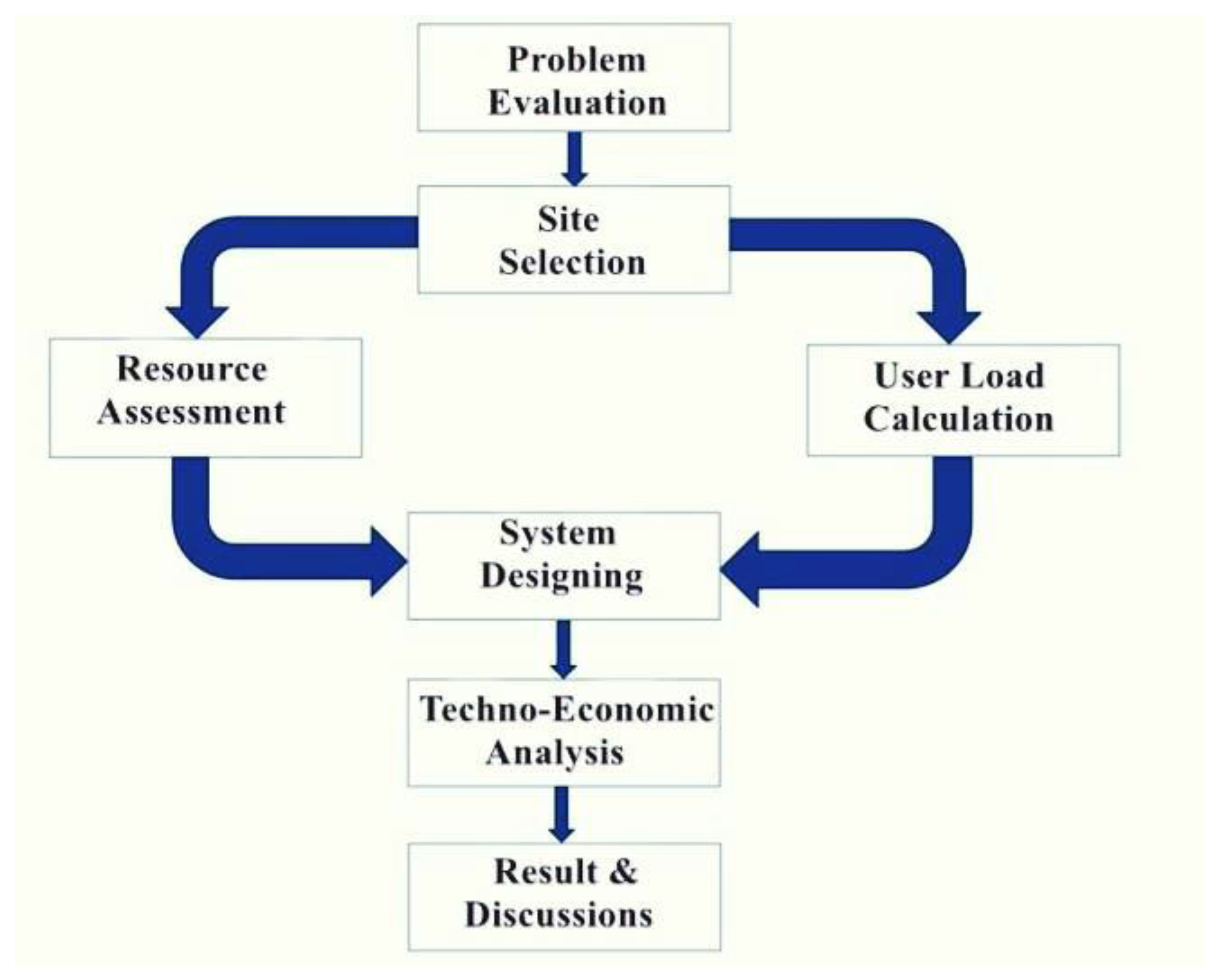

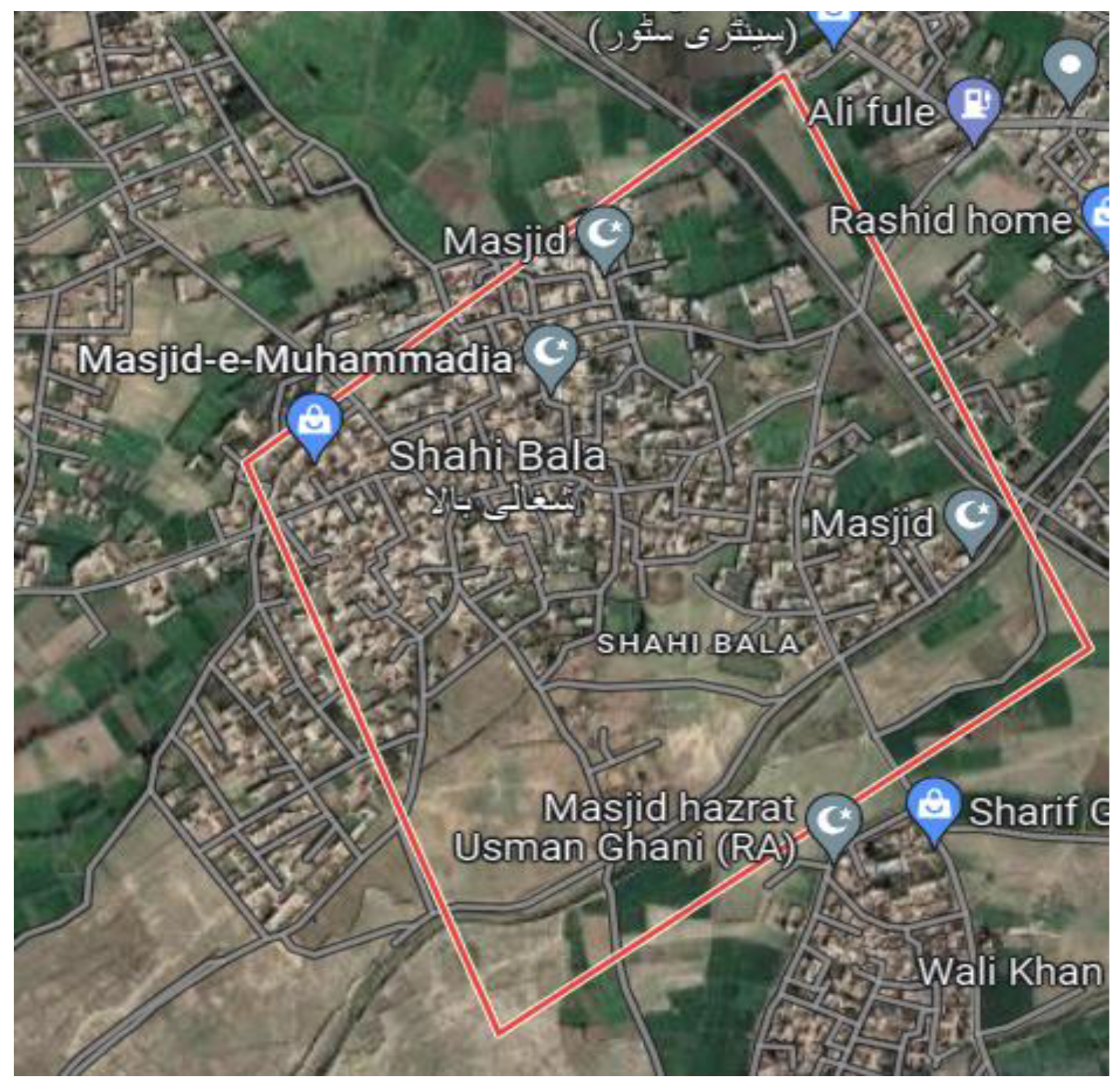
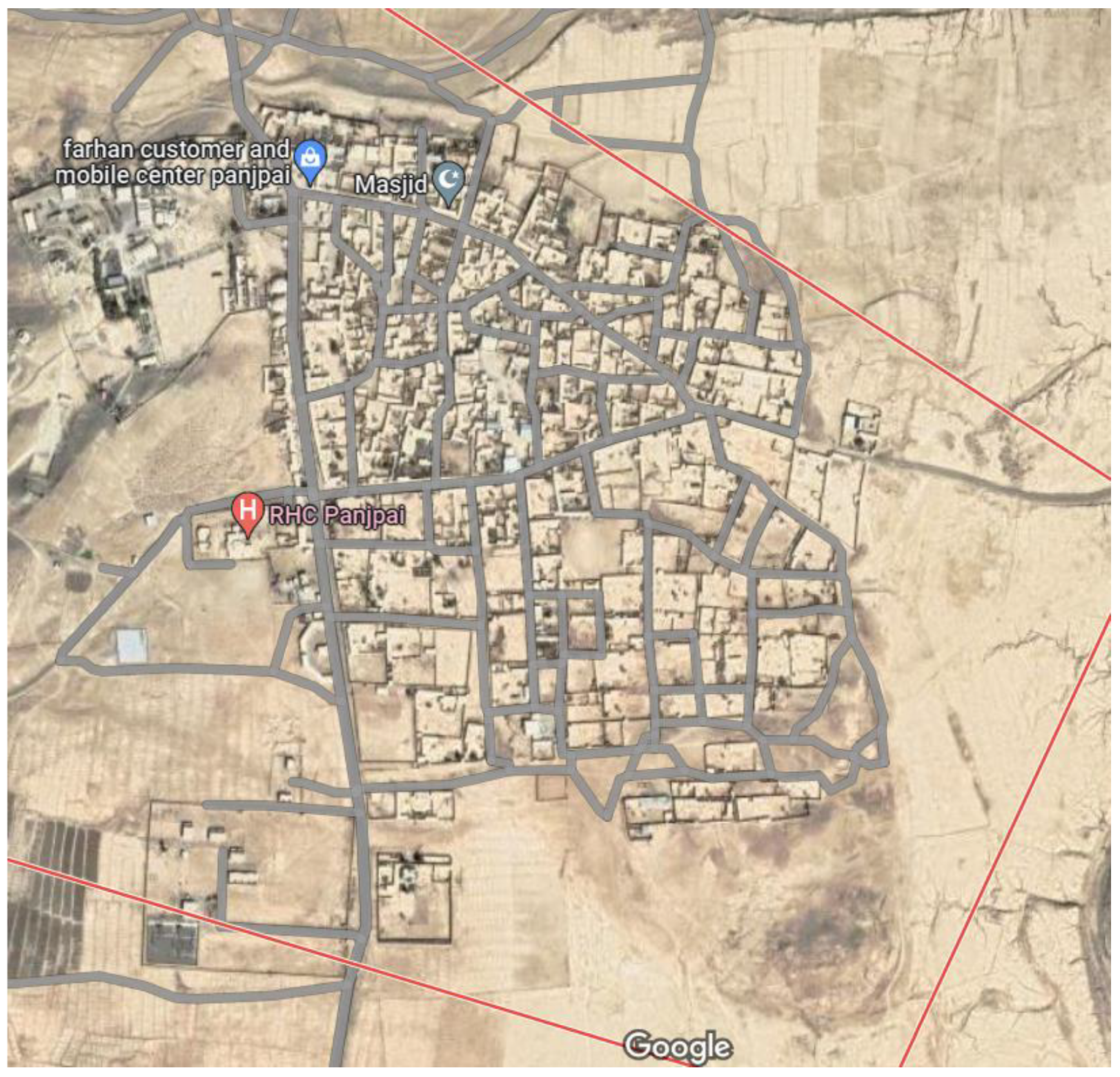
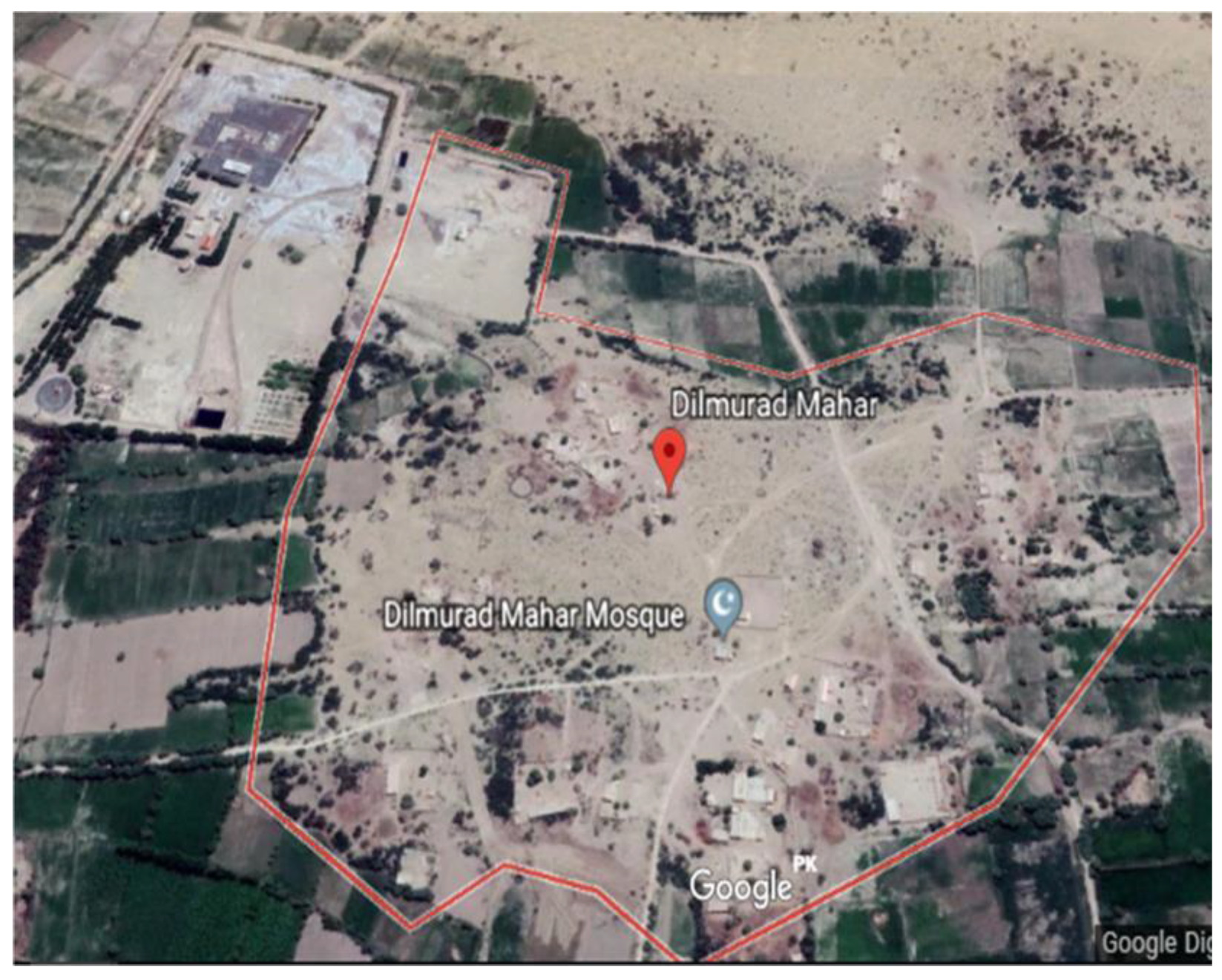
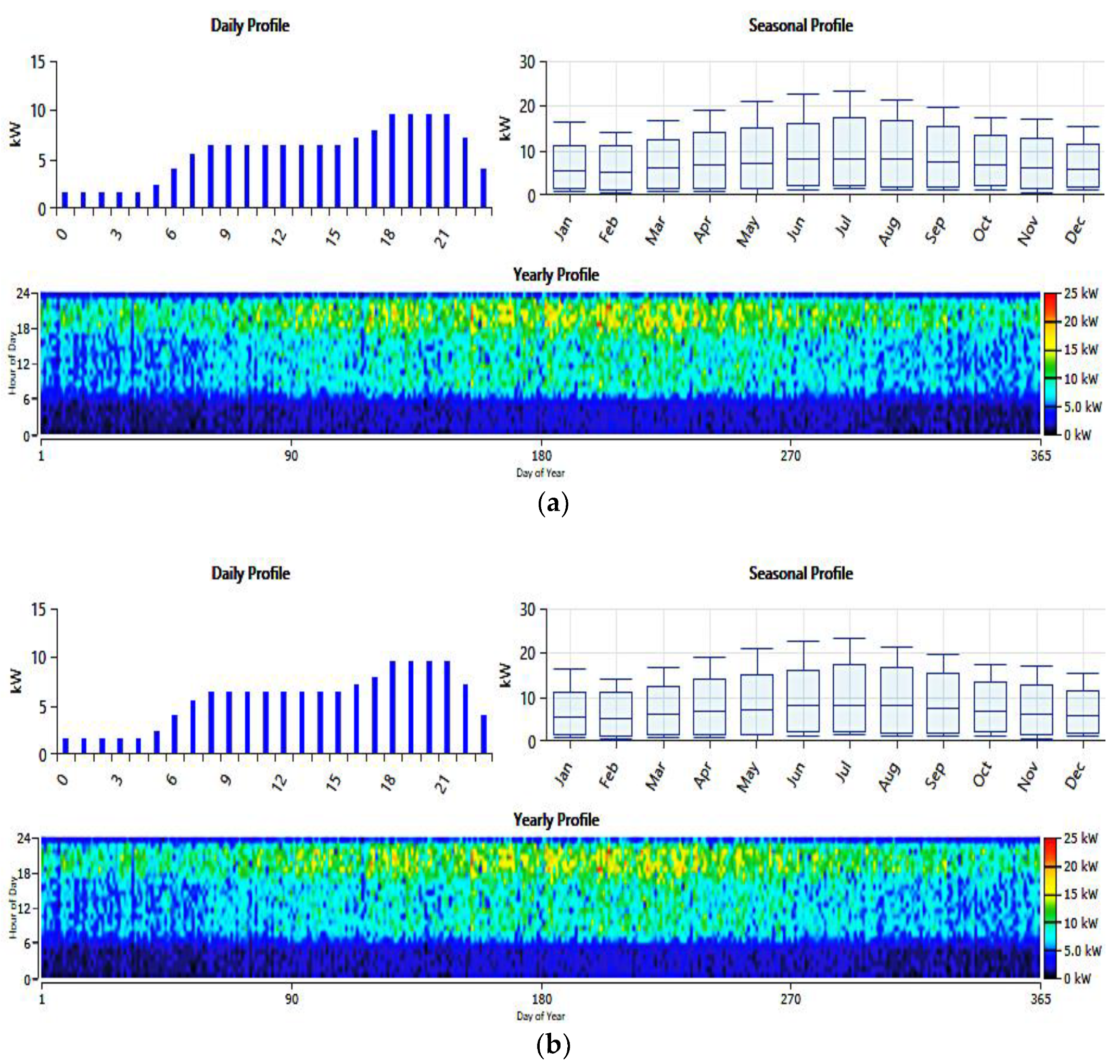
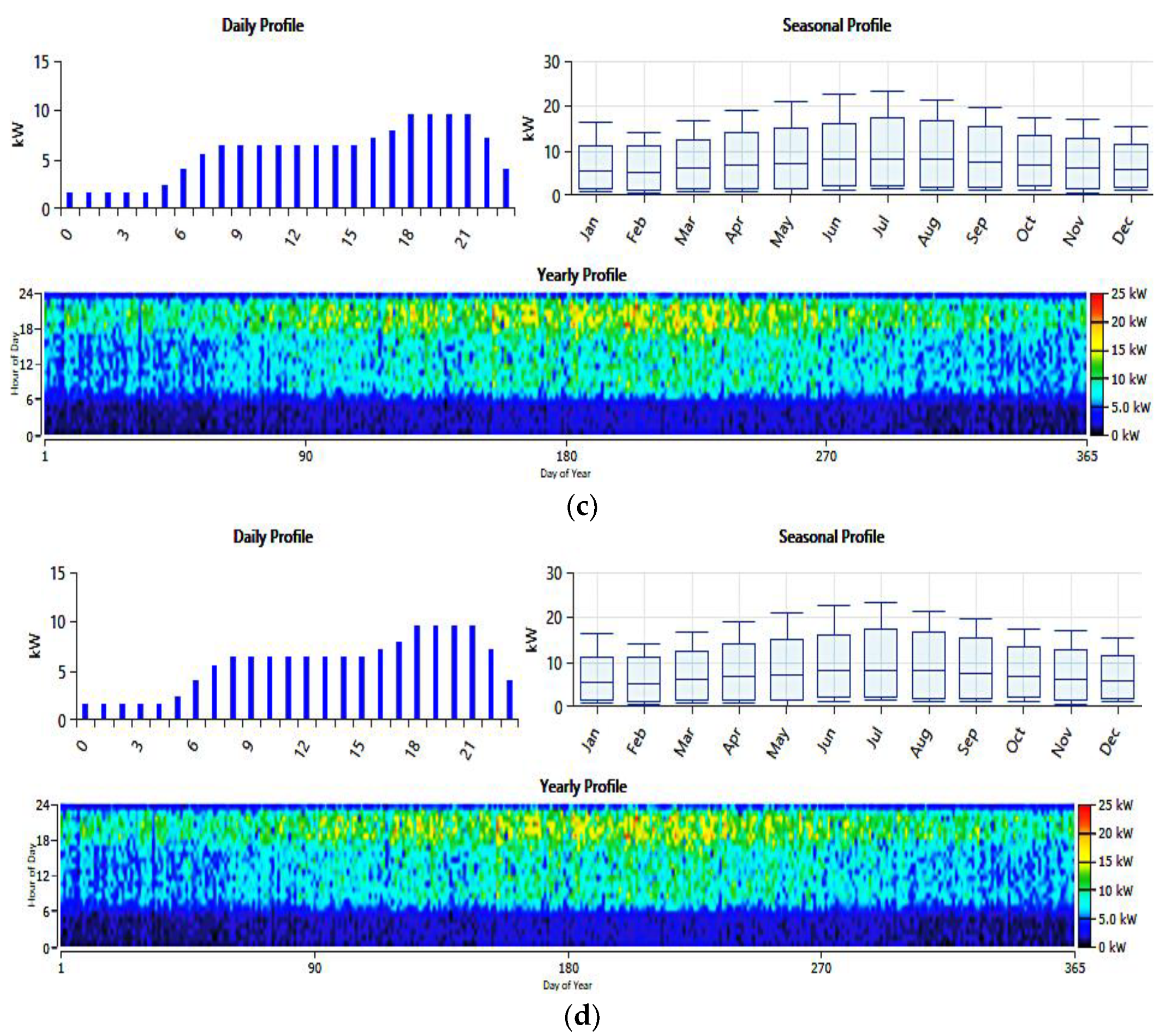

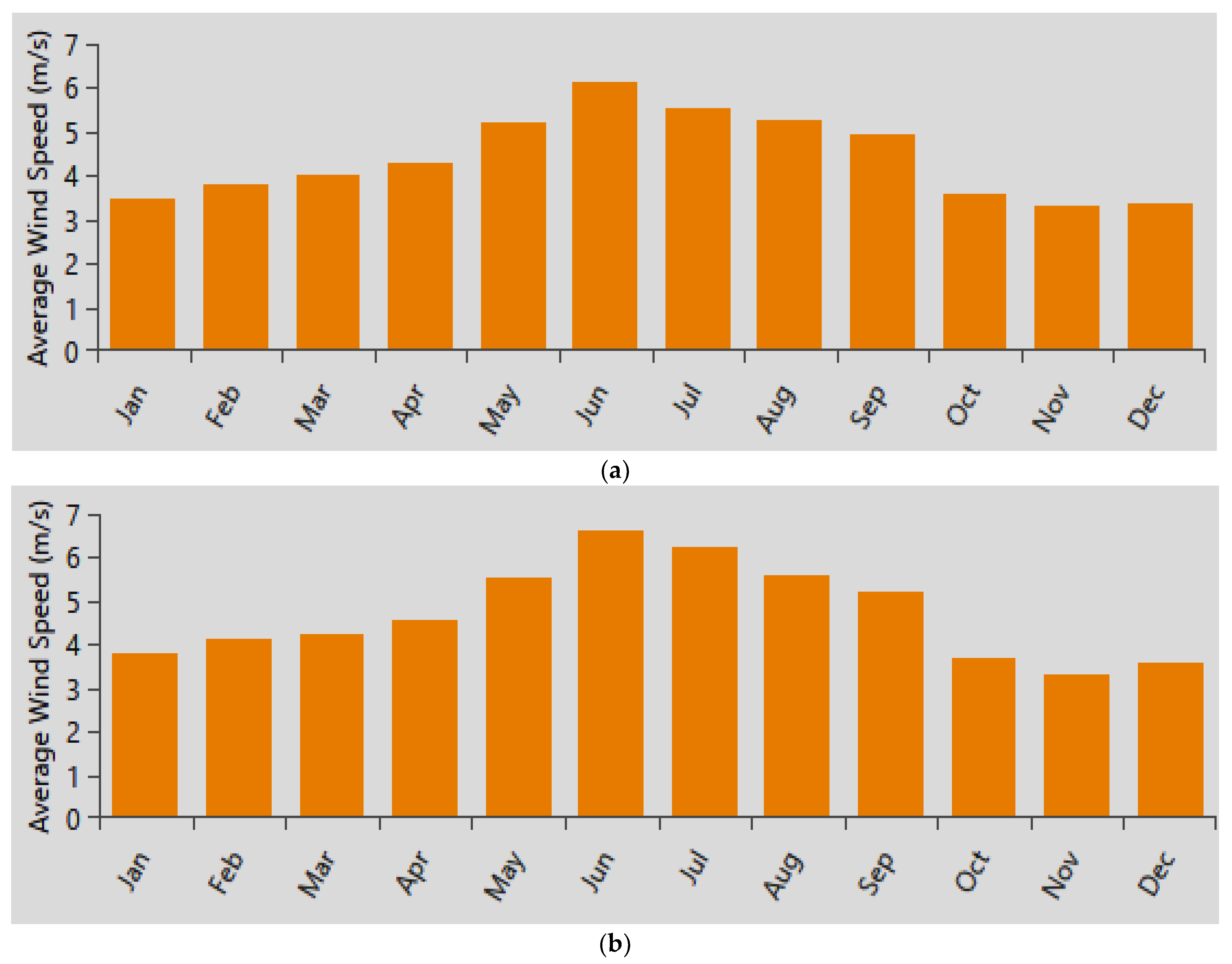
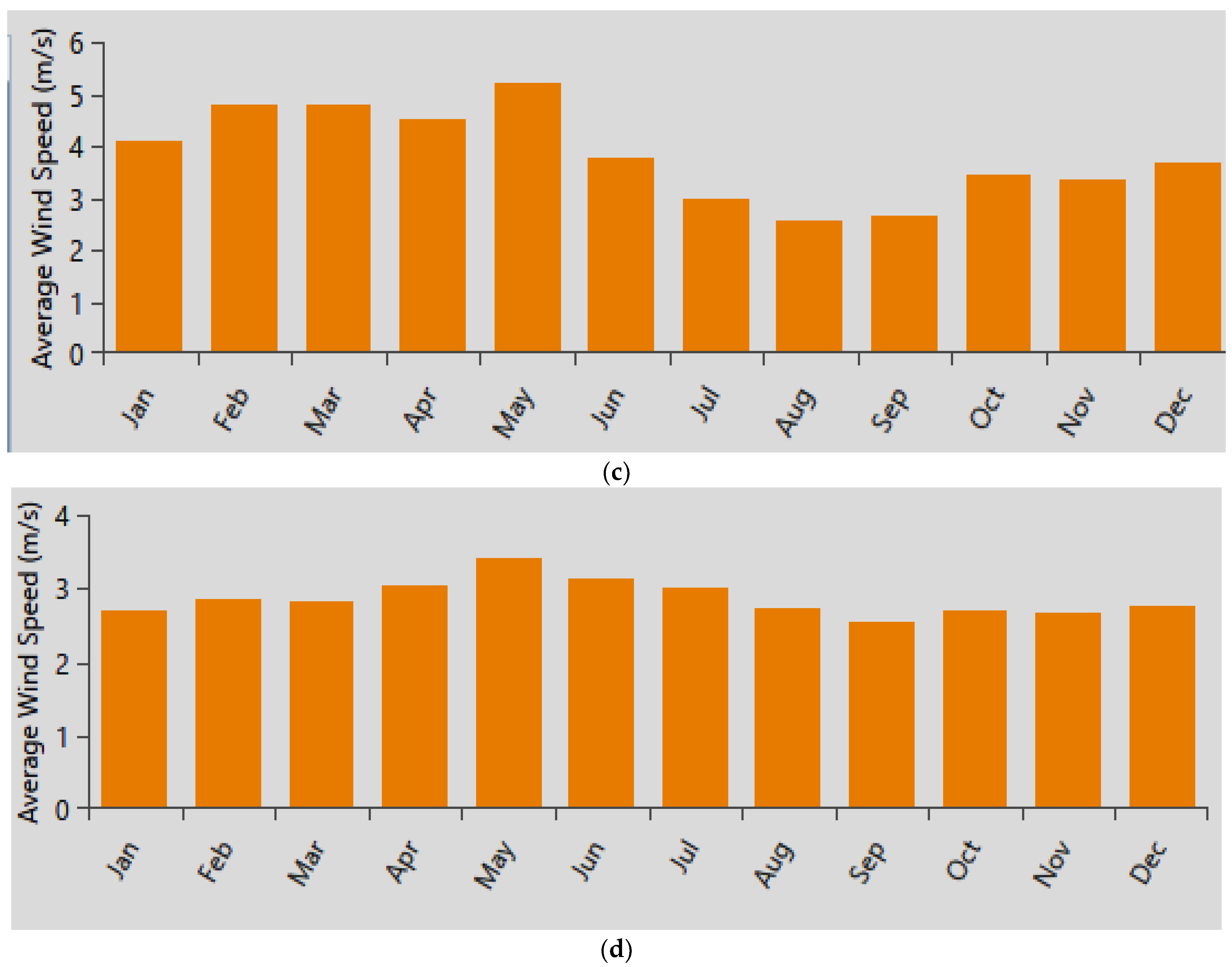
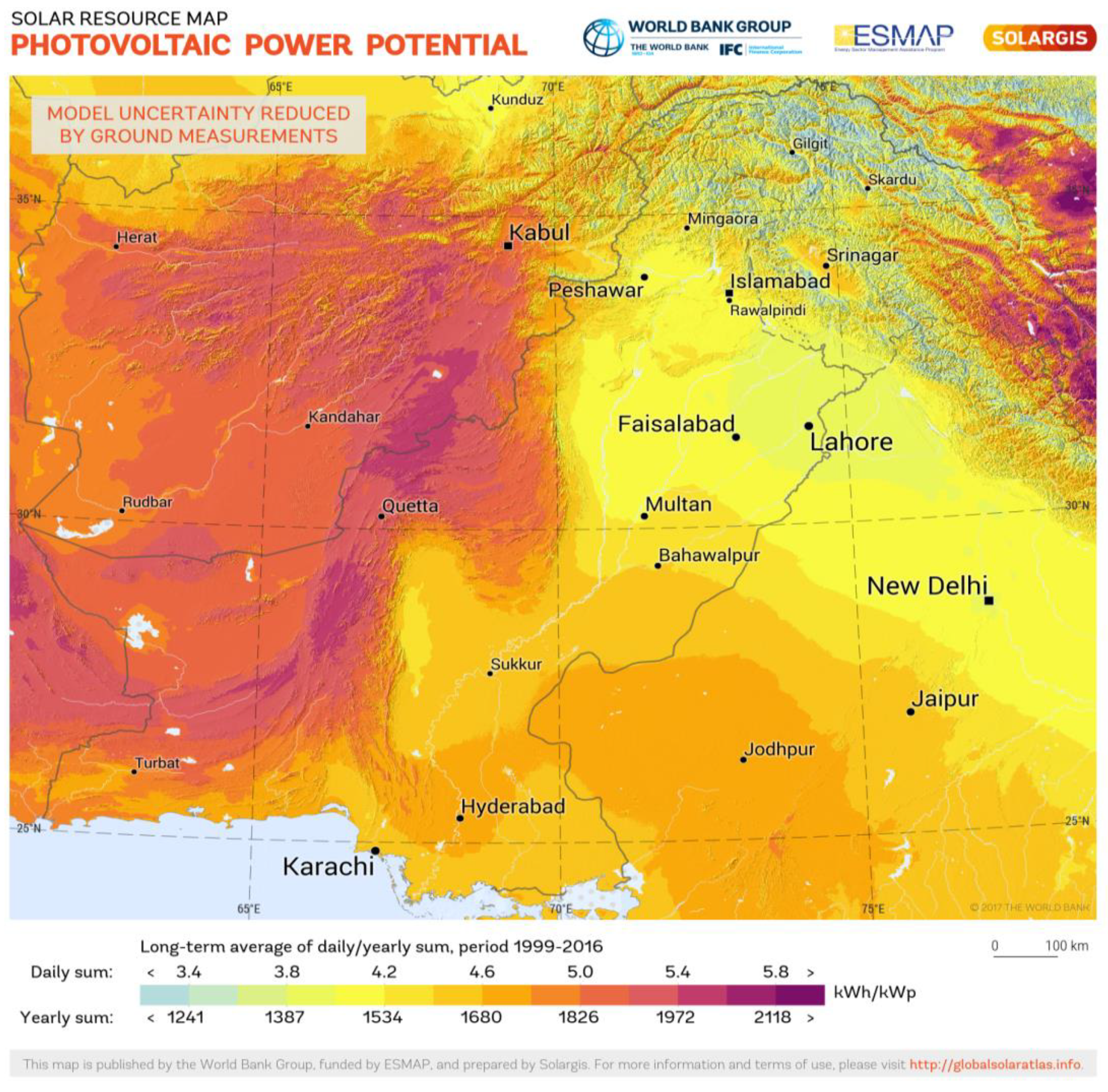
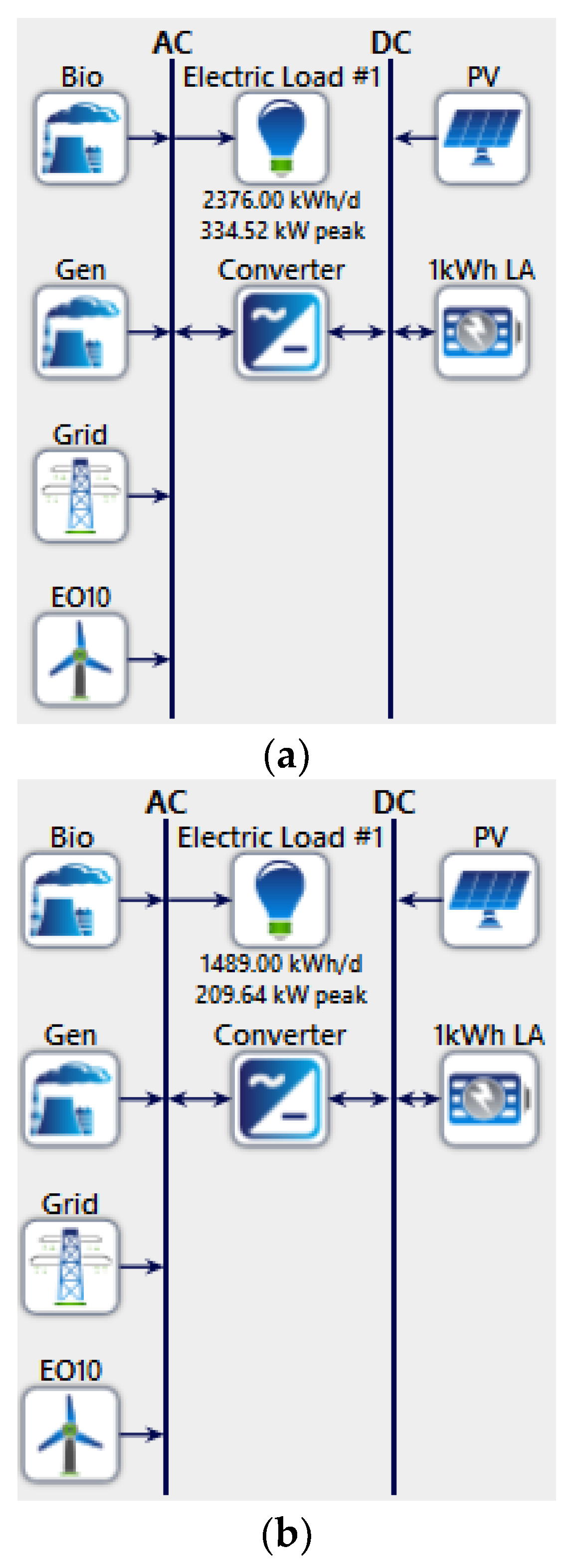
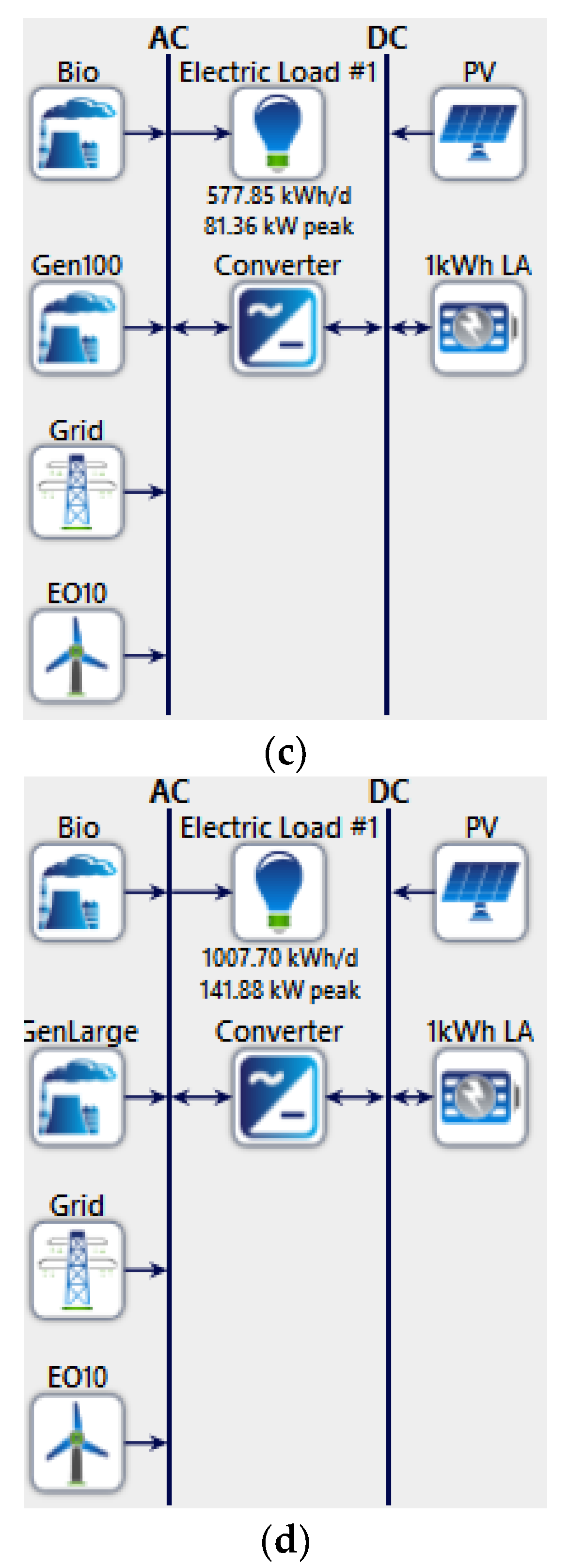

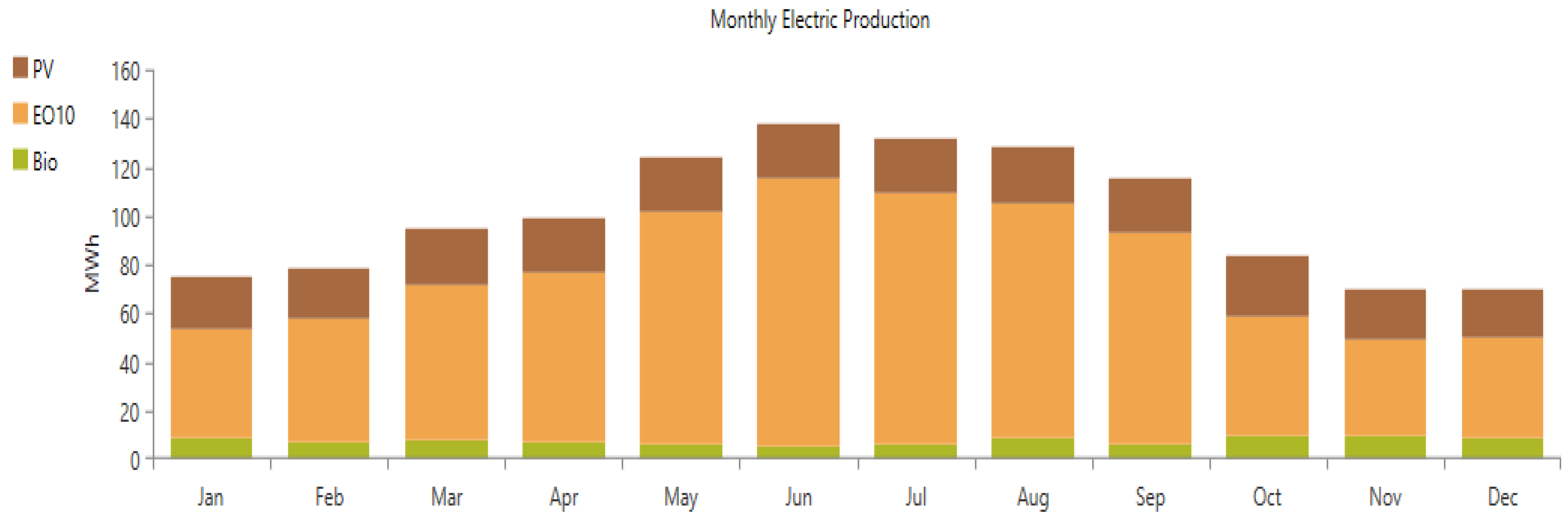

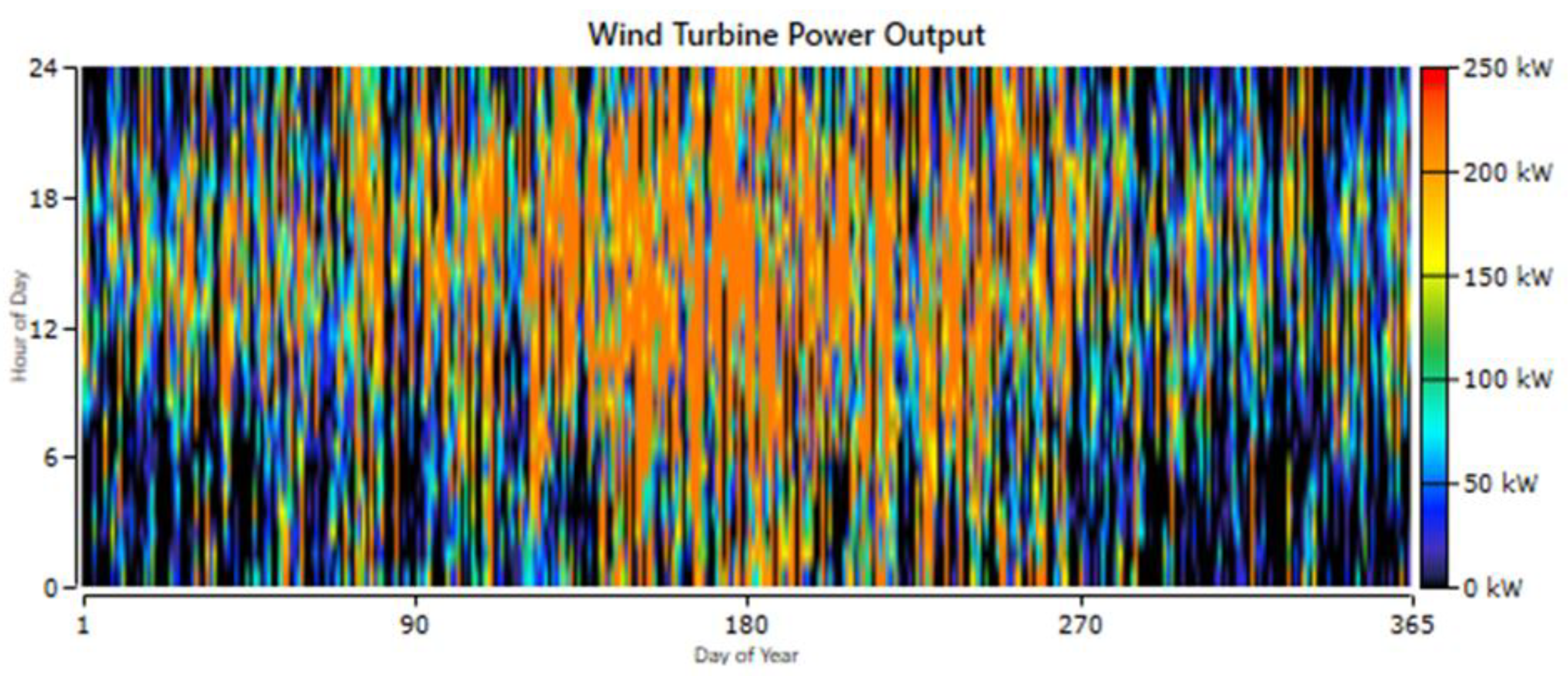
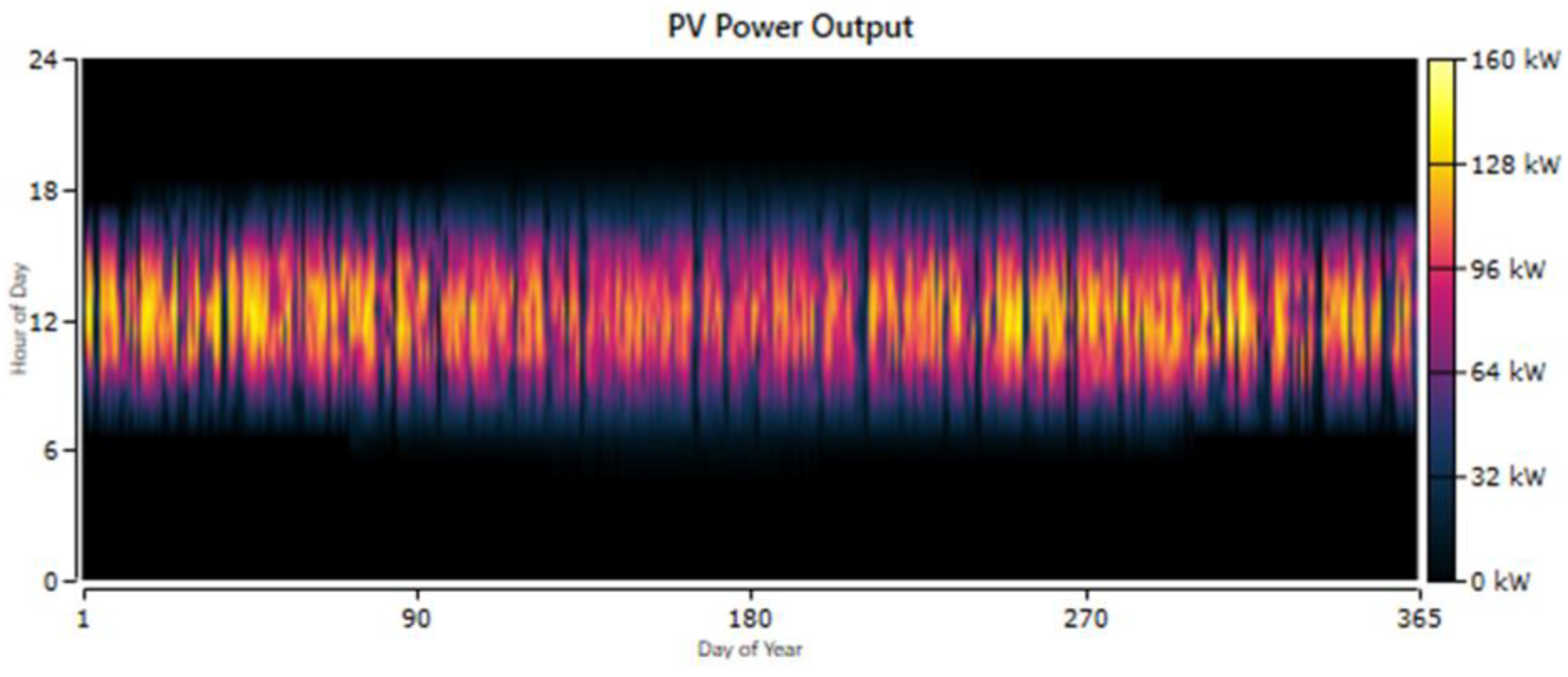
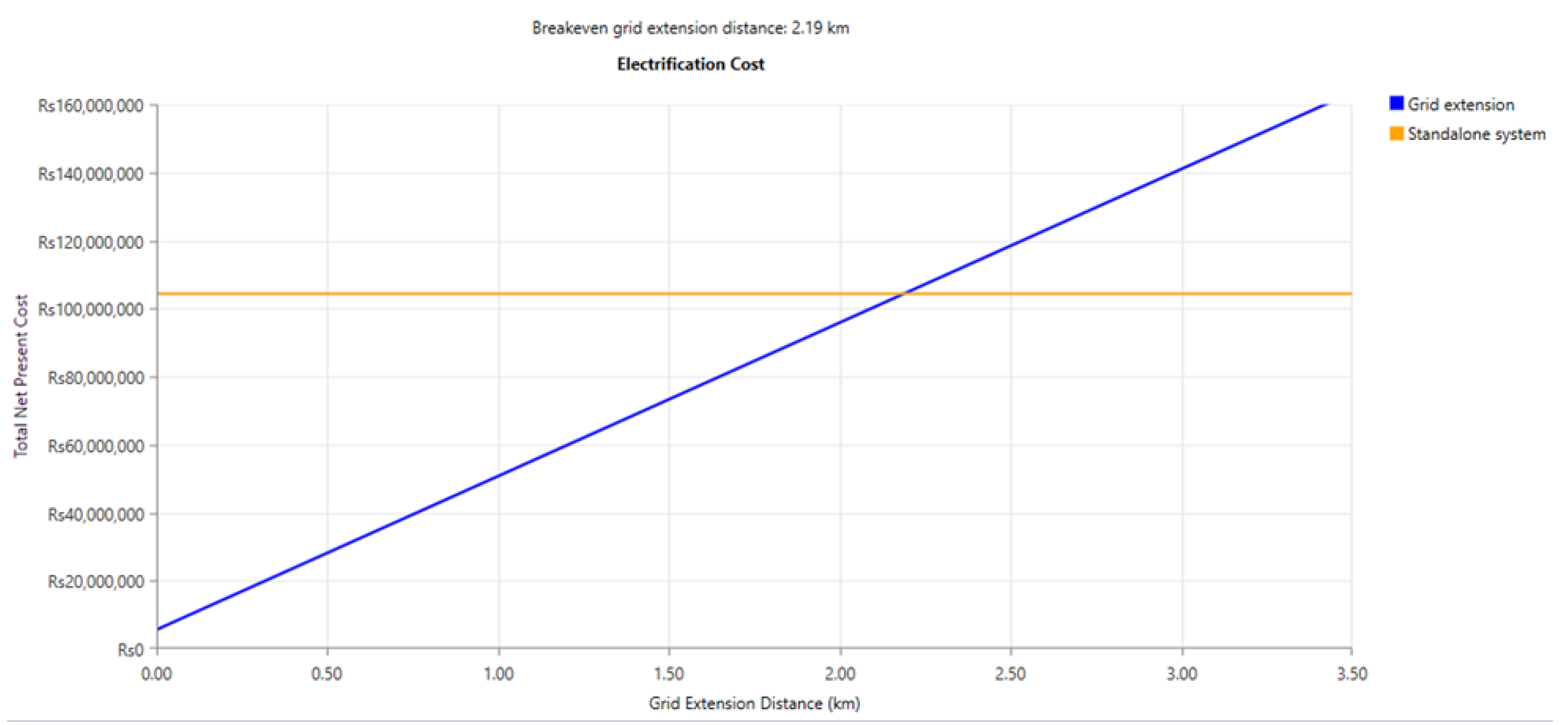



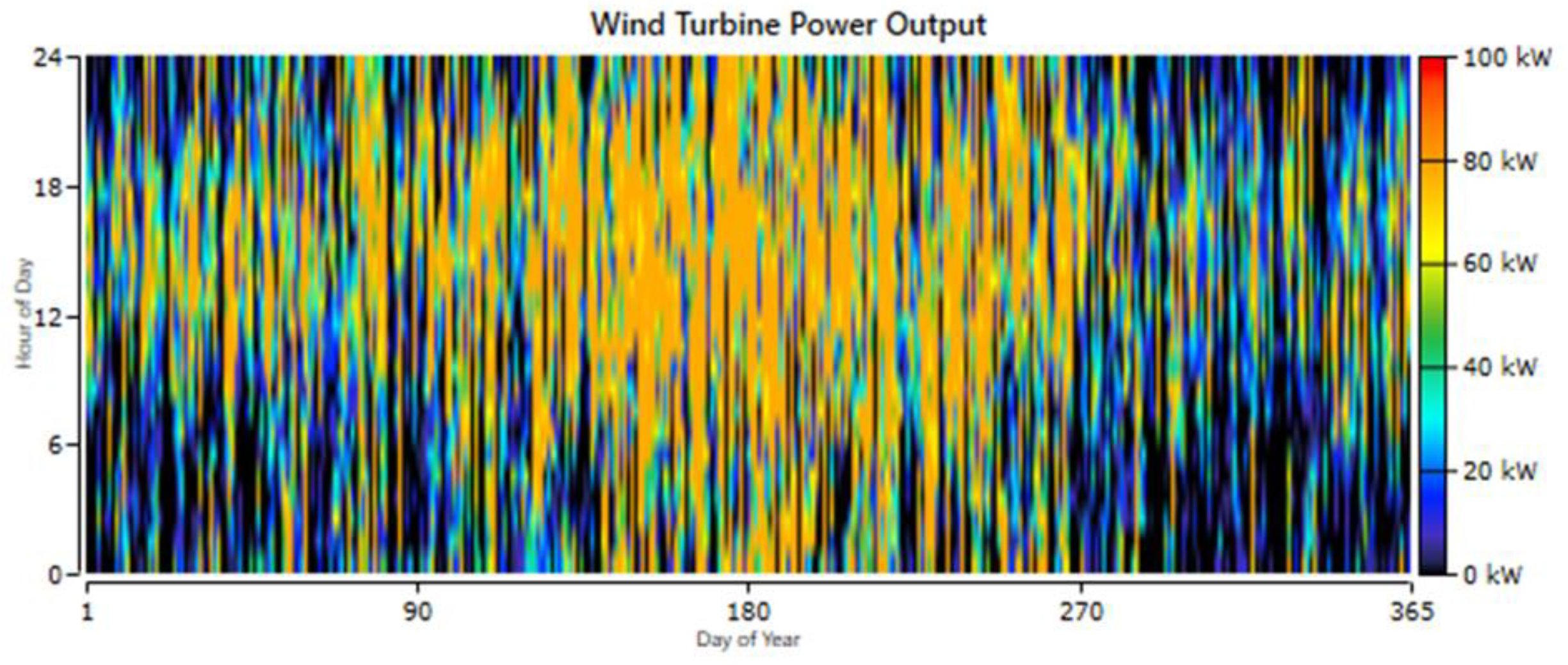
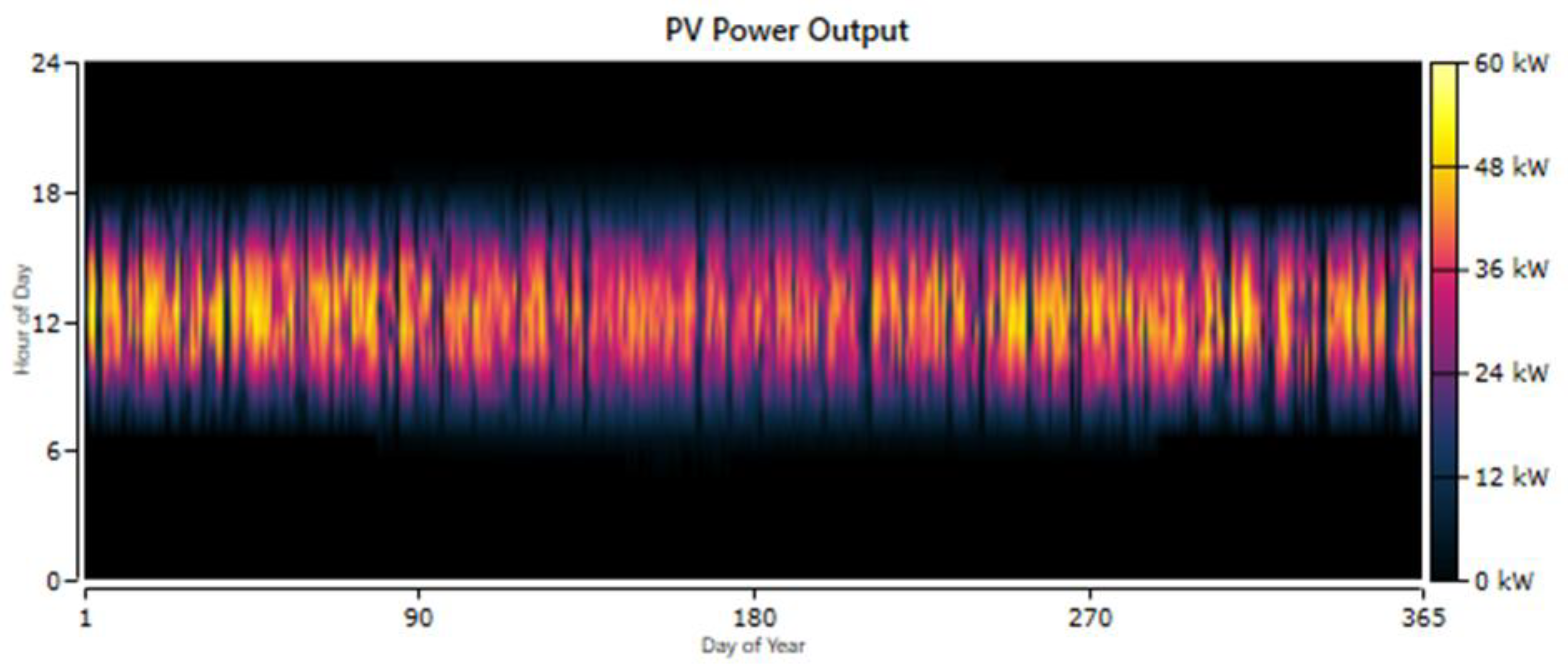
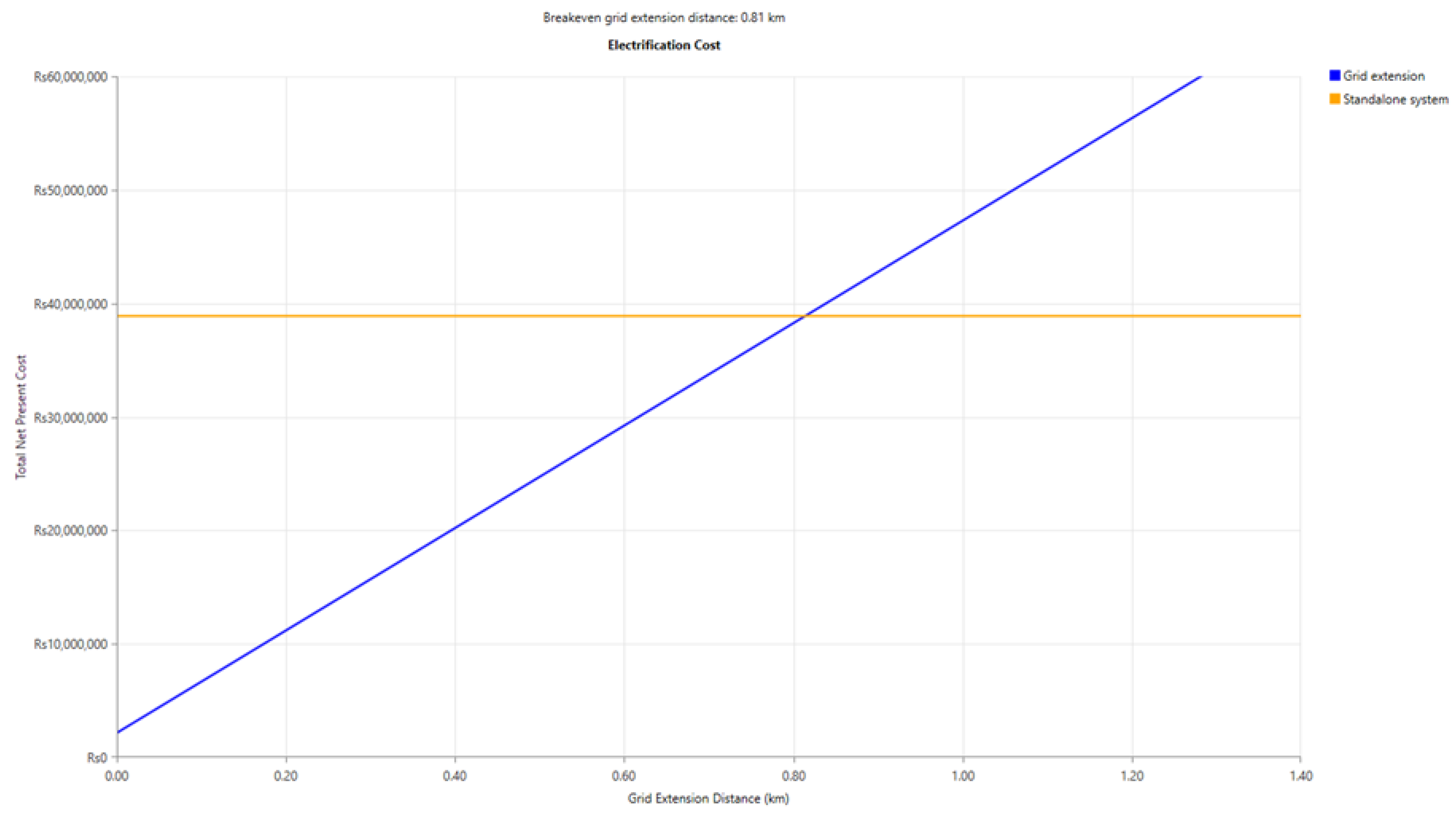
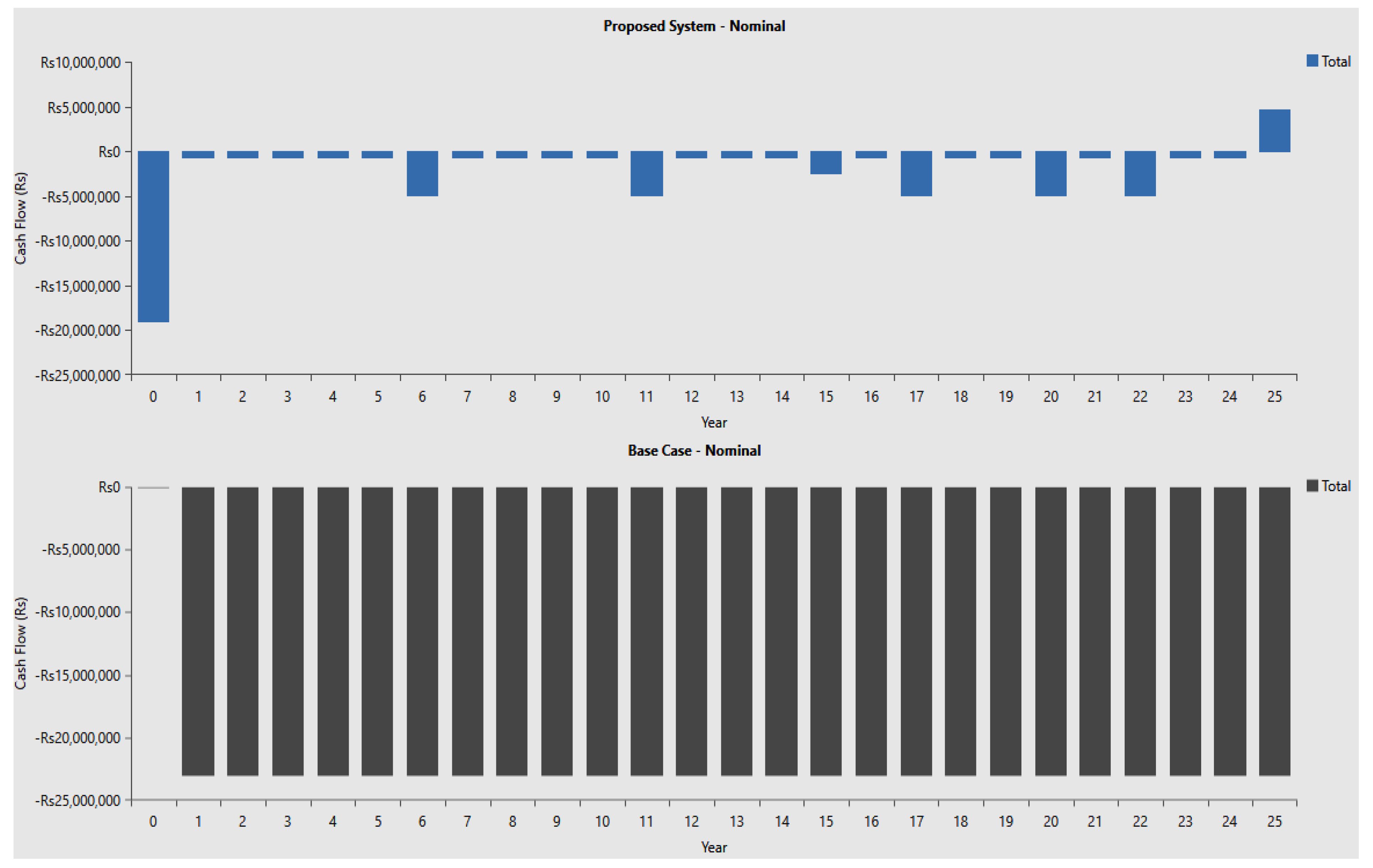

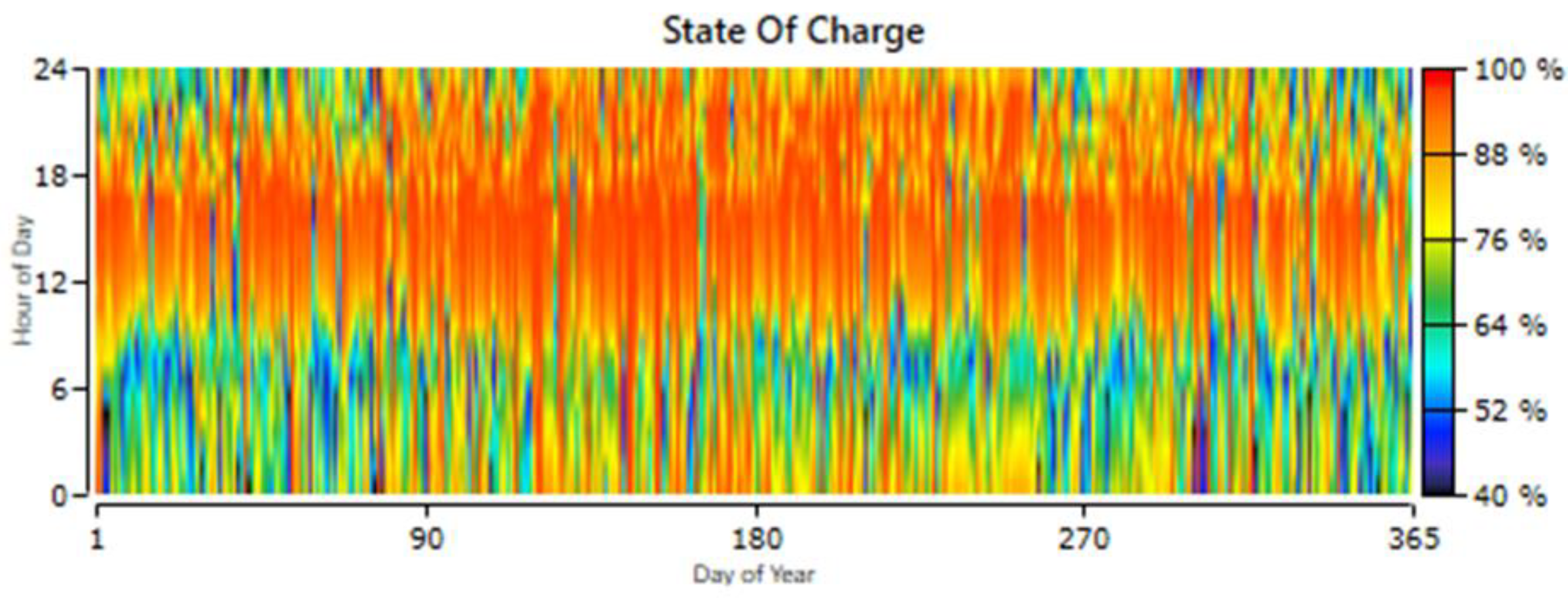
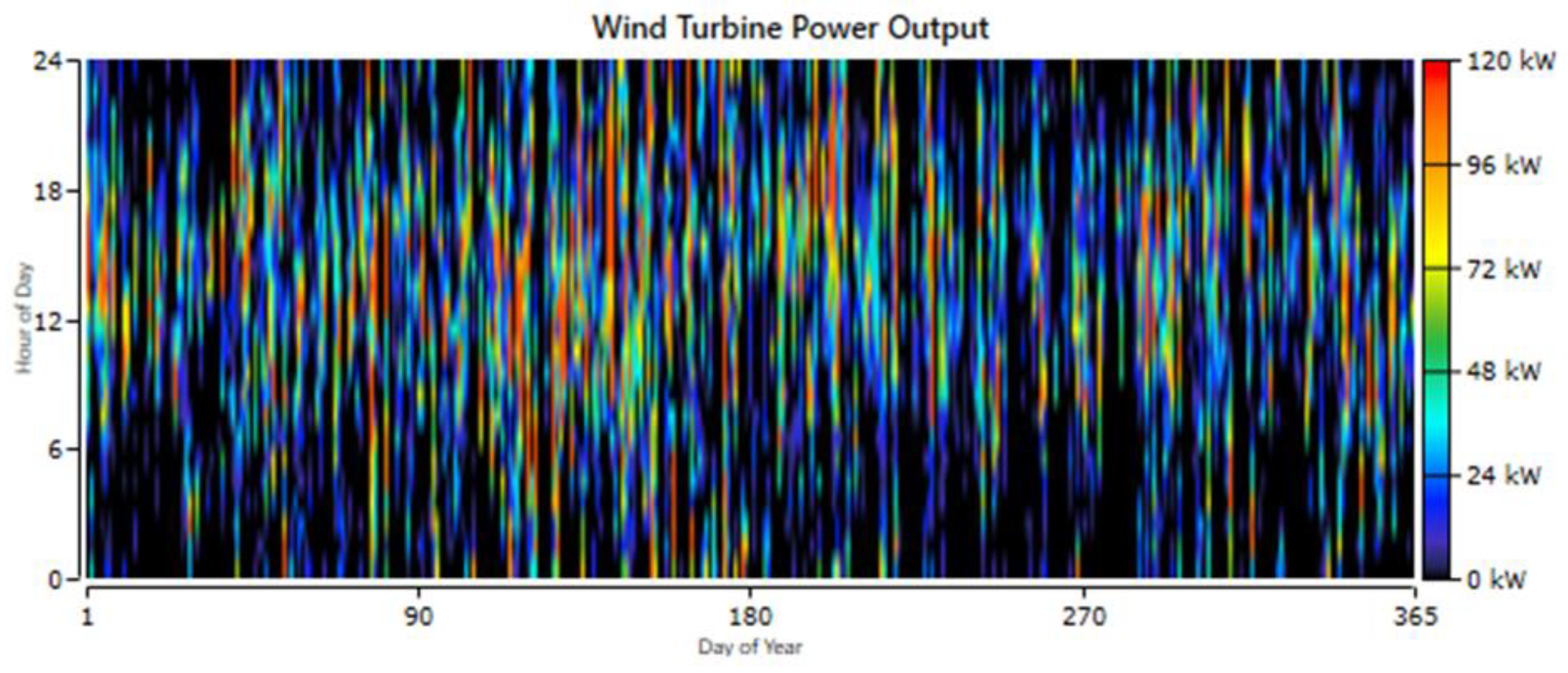
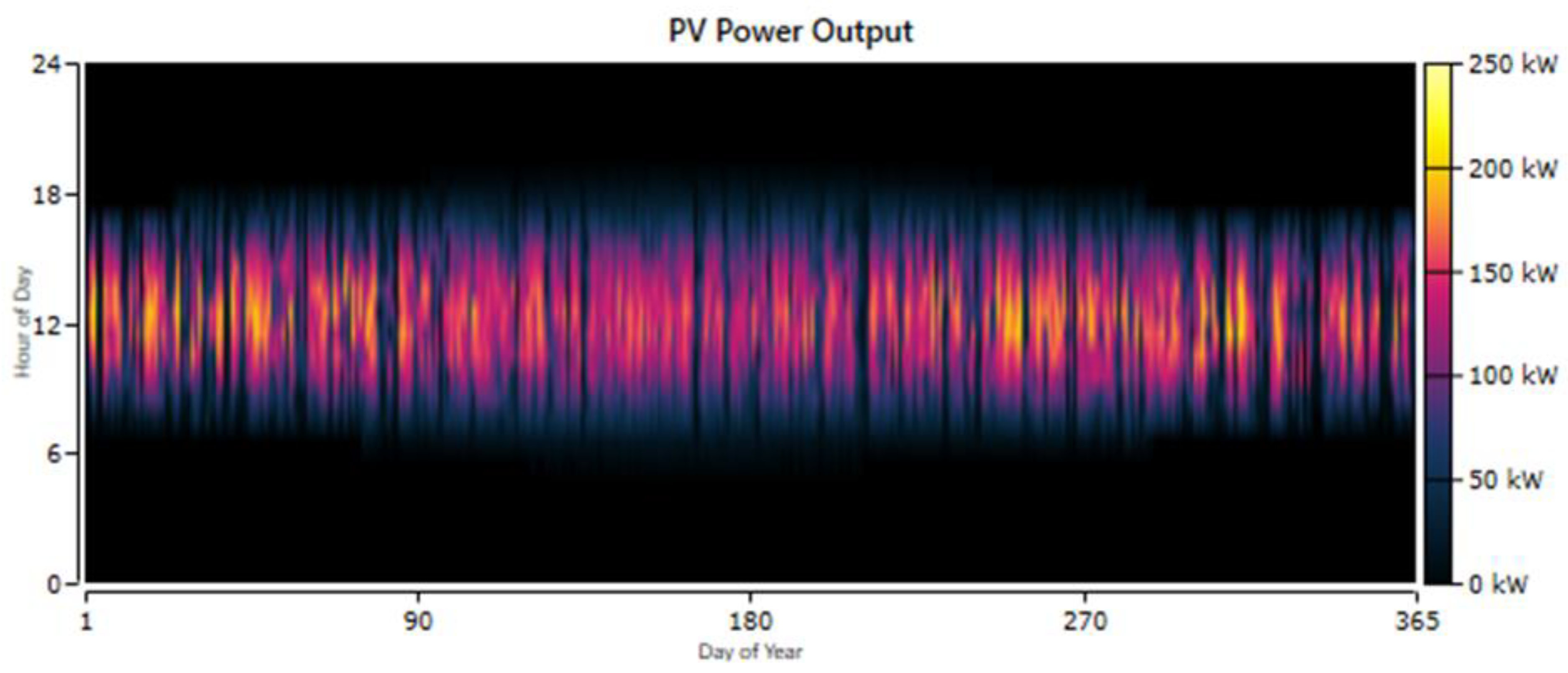
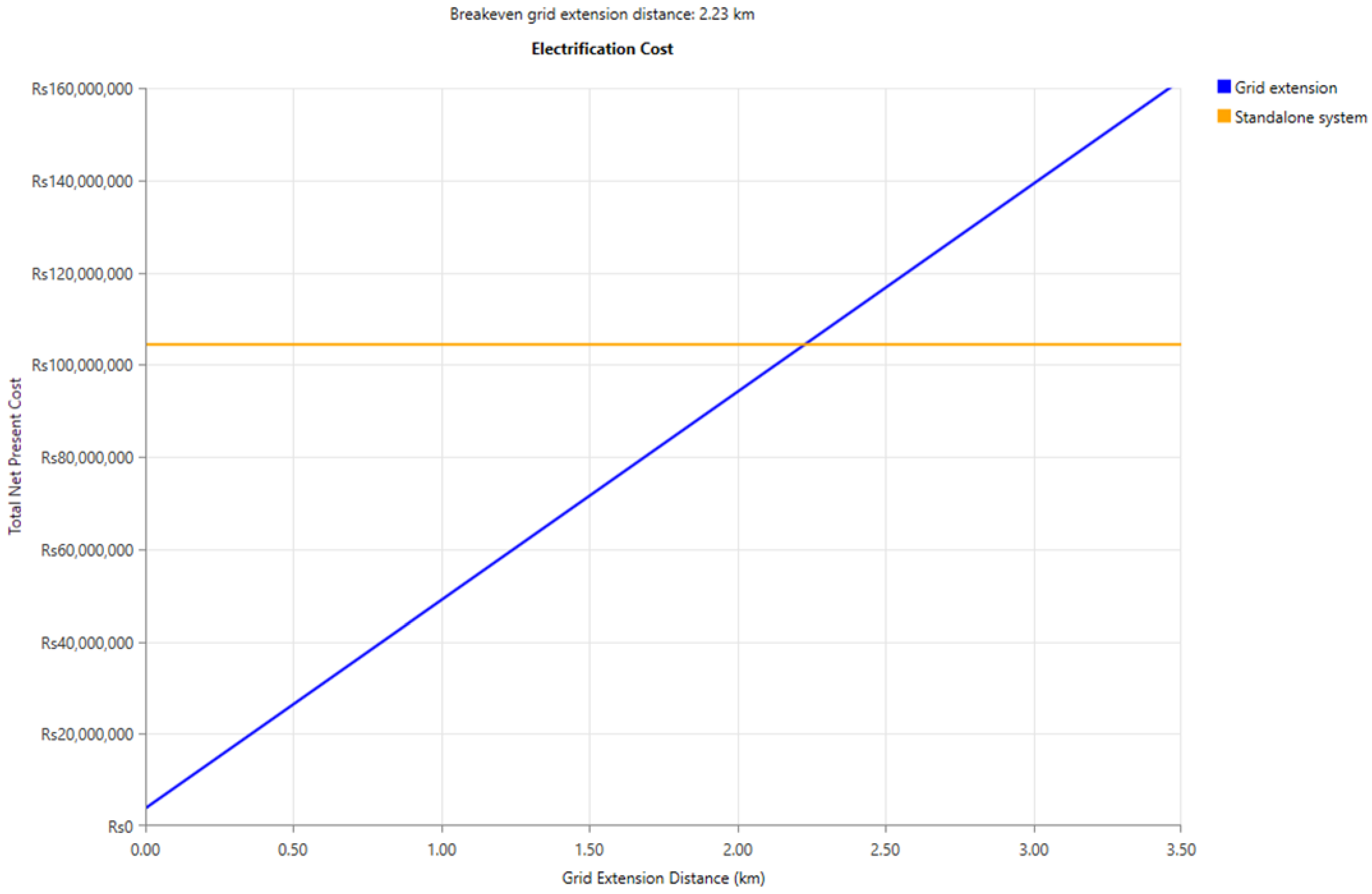
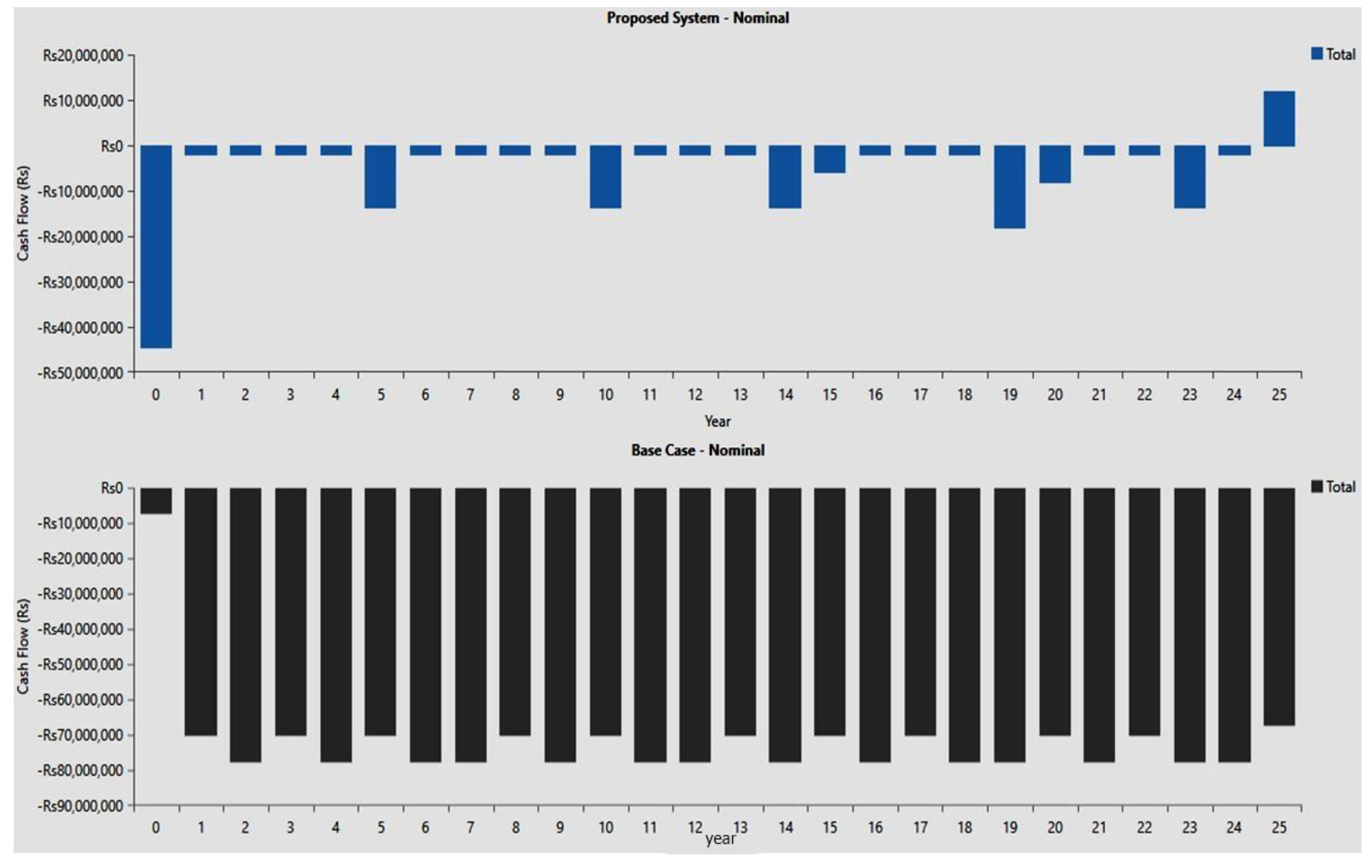


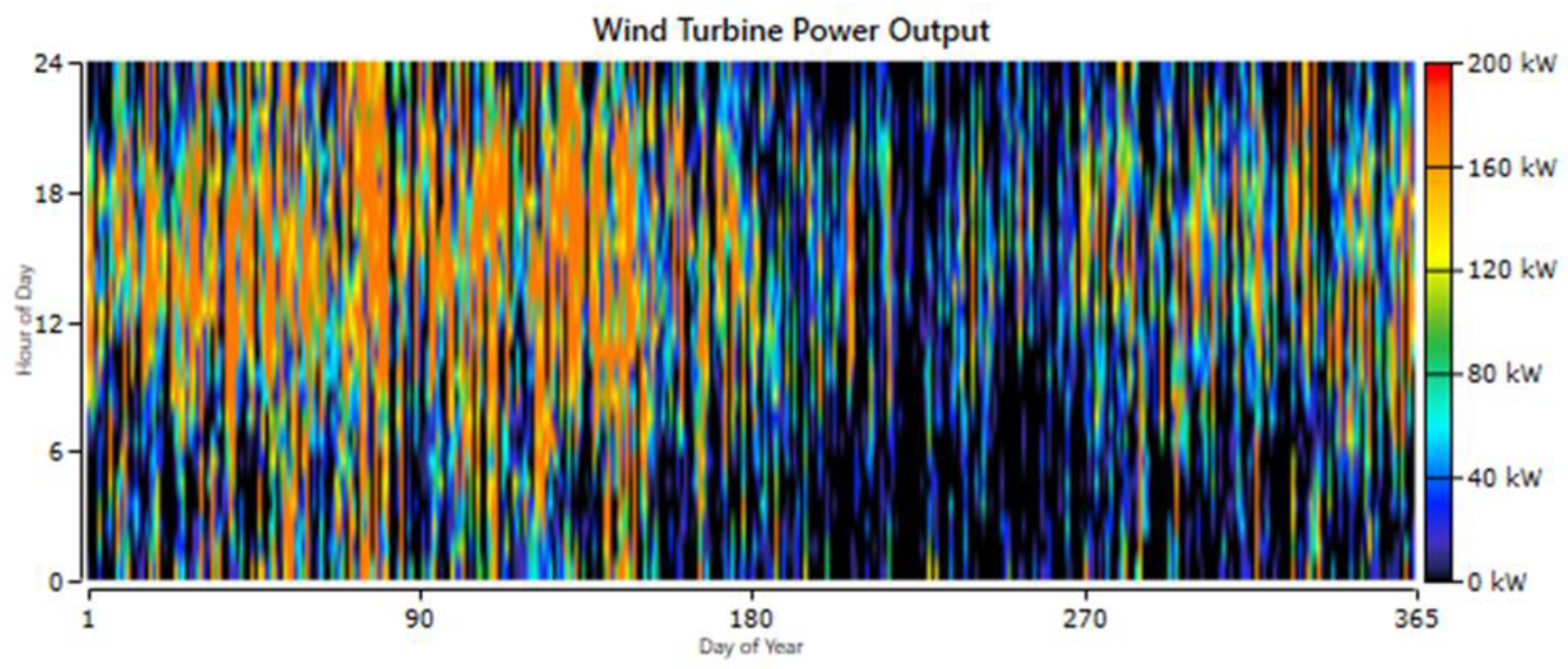
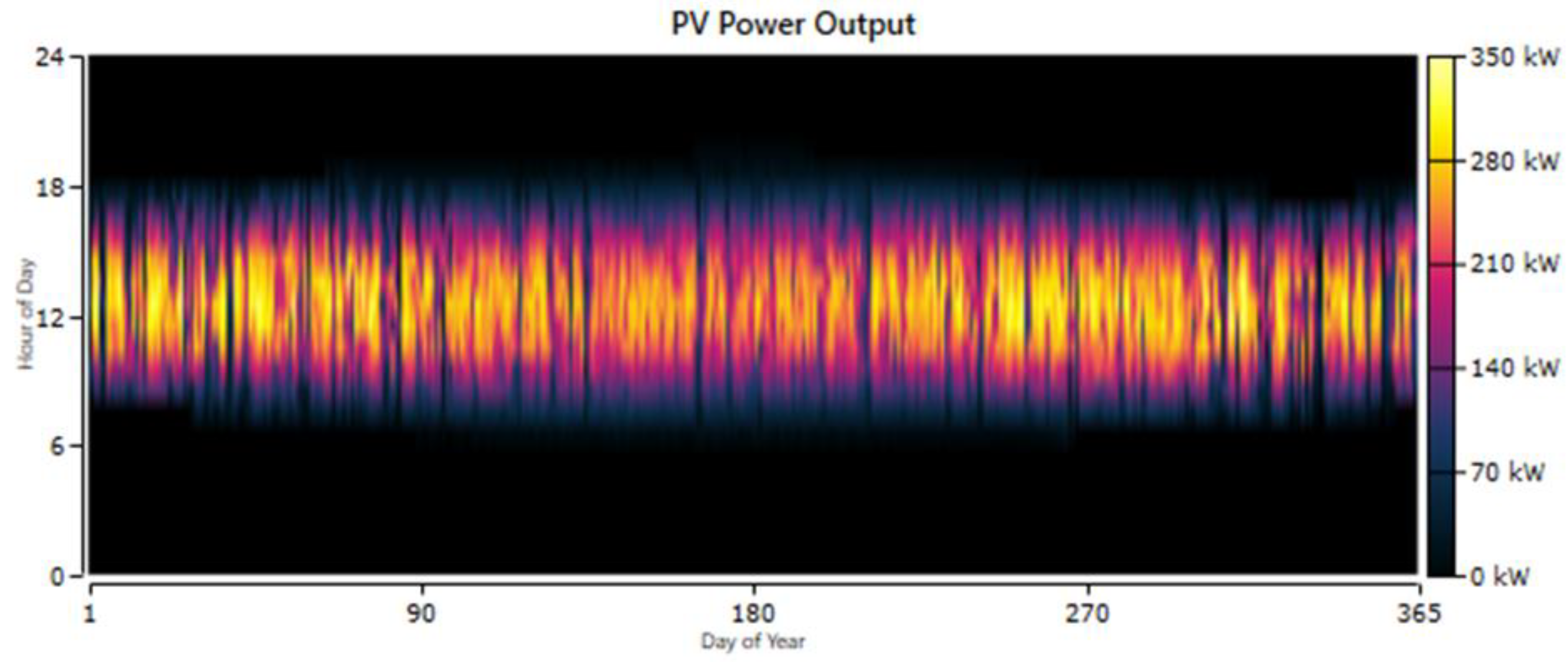
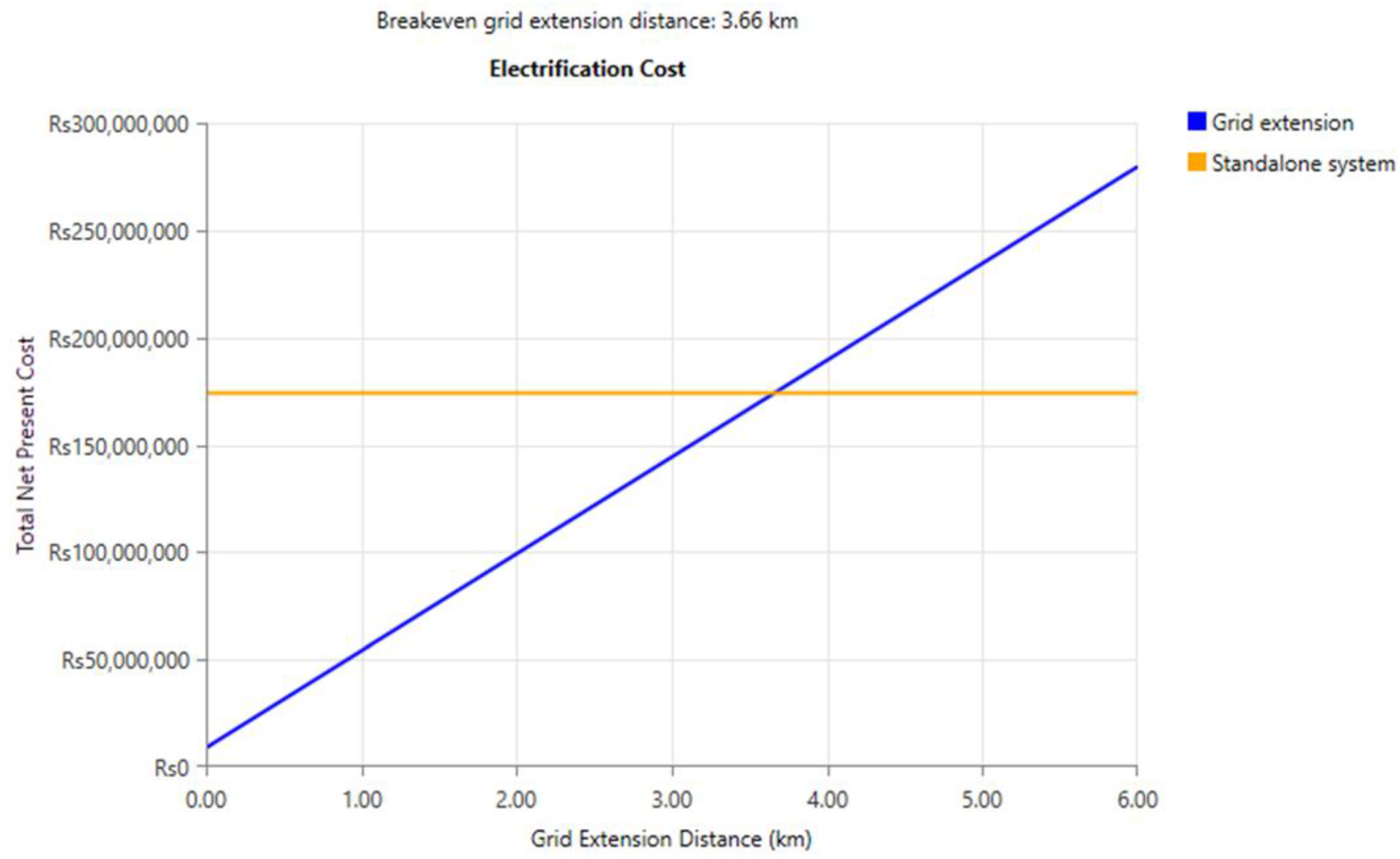
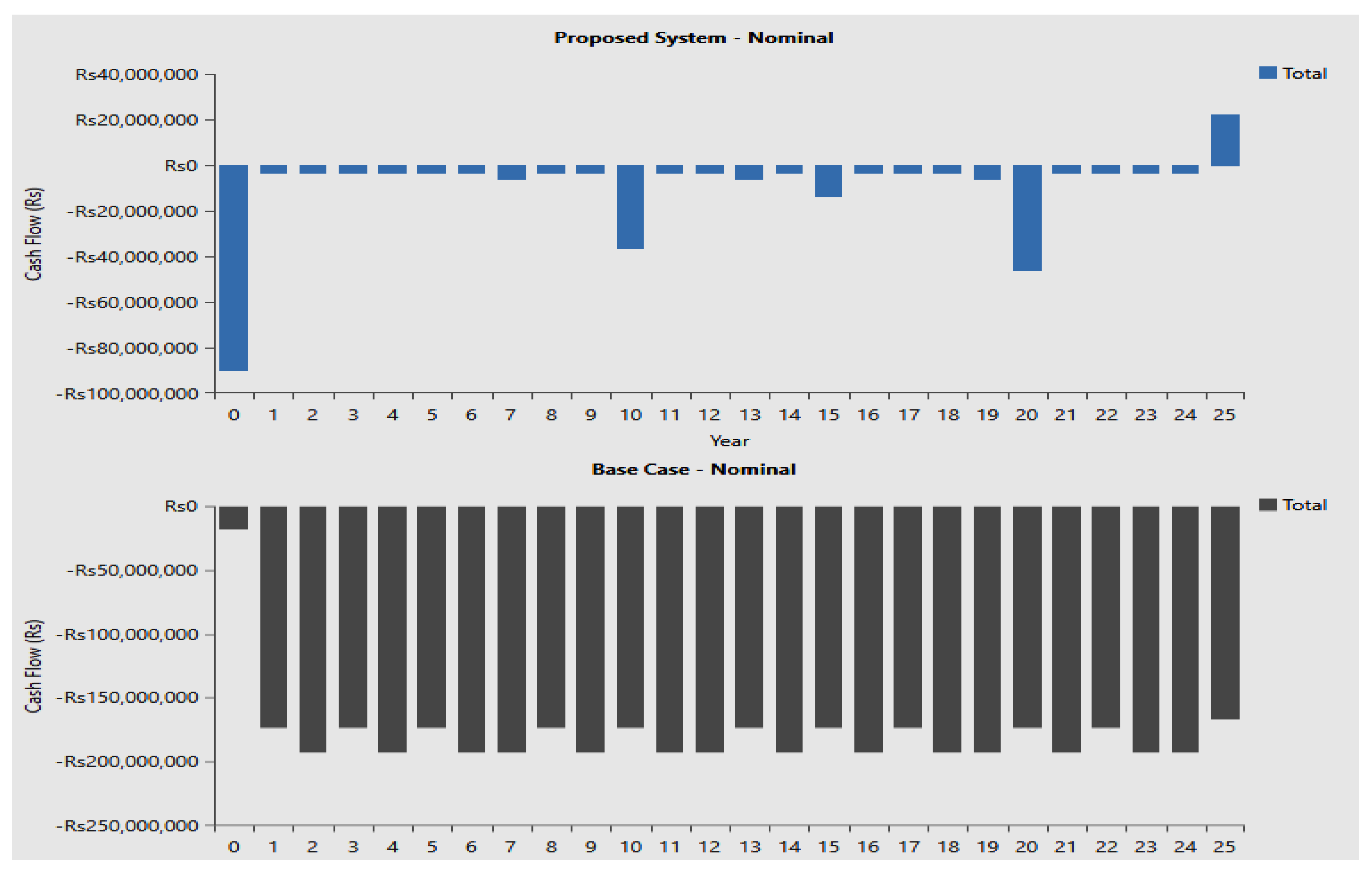
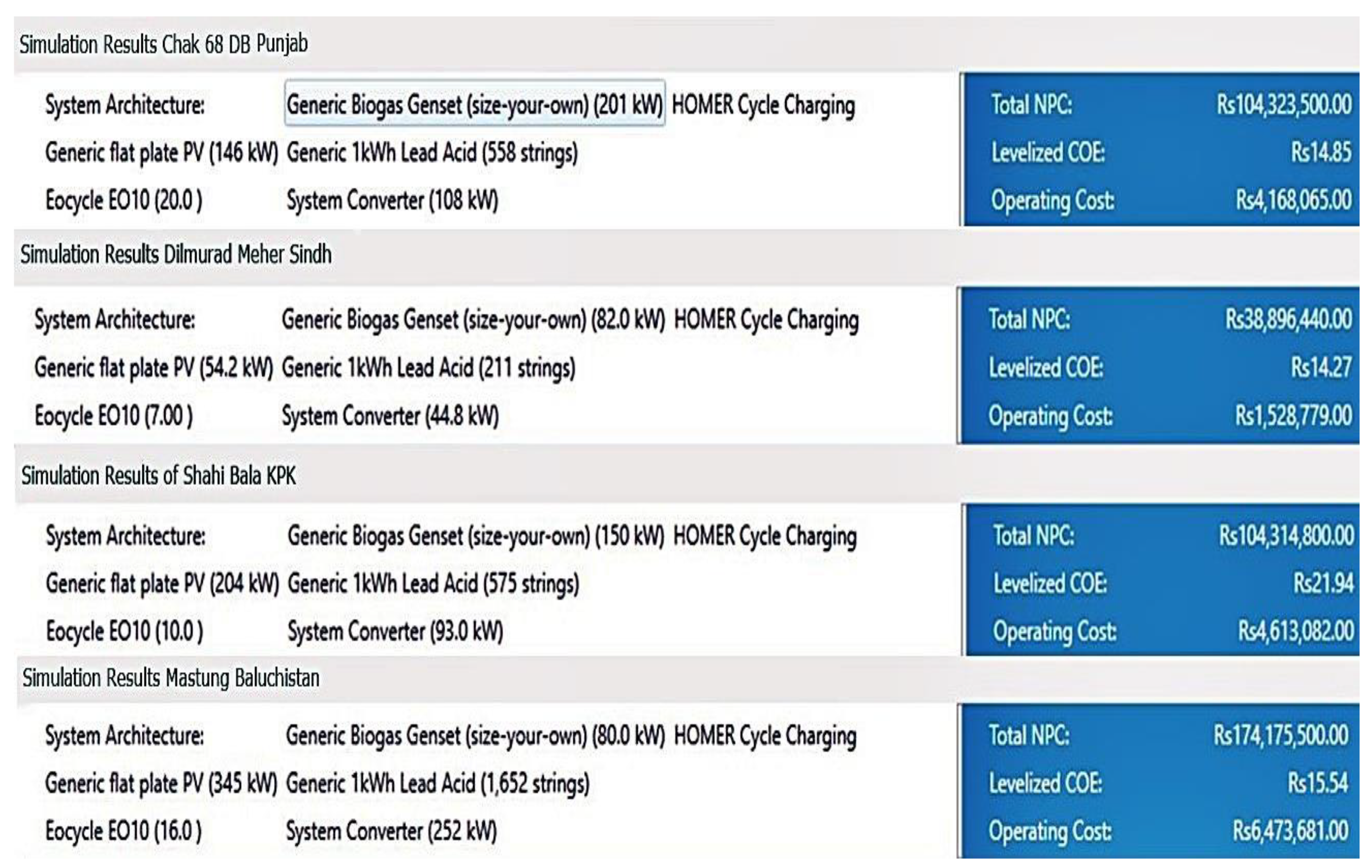
| Number of Cows | Per Head Animal Waste Production (kg/day) | Total Bio-Waste Production Per Day |
|---|---|---|
| 500 | 16 kg | 500 × 16 × 1000 = 8 tons |
| 250 | 16 kg | 250 × 16 × 1000 = 4 tons |
| 310 | 16 kg | 310 × 16 × 1000 = 5.1 tons |
| 400 | 16 kg | 400 × 16 × 1000 = 6.4 tons |
| Length of Transmission Line | 95.74 kM | |
|---|---|---|
| Capital Cost (million-Pkr) | 1864.04 | 19.47/kM |
| Operation & Maintenance Cost (million-Pkr) | 190.02 | 1.98/kM |
| Grid Power Tariff (Pkr) | 0.79/kWh | |
| Capital Cost (Rs/kilowatt) | 50,000 |
|---|---|
| Cost of fuel (Rs/ton) | 250 |
| Lower heating value (MJ/kg) | 5.50 |
| Density (kg/m3) | 0.72 |
| Carbon (%) | 5.0 |
| Sulfur (%) | 0 |
| Parameters | Values |
|---|---|
| Capital cost (Rs) | 20,000 |
| Replacement cost (Rs) | 14,000 |
| Initial state of charge SOC (%) | 100 |
| Minimum SOC (%) | 40 |
| Maximum Discharge current (A) | 500 |
| Nominal Capacity (kWh) | 01 |
| Life (years) | 05 |
| Remote Locations | Initial Capital Cost (PKR) | Operating Cost (PKR) | COE (PKR/KWh) | Total NPC (PKR) | Carbon Emissions Saved (kg/year) | Payback Period (years) |
|---|---|---|---|---|---|---|
| Chak 68 DB, Punjab | 100.881 M | 4.168 M | 14.85 | 104.323 M | 538,664 | 3.1 |
| Dilmurad Maharr, Sindh | 38.266 M | 1.529 M | 14.27 | 38.896 M | 238,361 | 1.9 |
| Shahi Bala, KPK | 89.358 M | 4.613 M | 21.94 | 104.314 M | 325,718 | 2.8 |
| Mastung, Baluchistan | 180.973 M | 6.473 M | 15.54 | 174.175 M | 805,288 | 4.1 |
Disclaimer/Publisher’s Note: The statements, opinions and data contained in all publications are solely those of the individual author(s) and contributor(s) and not of MDPI and/or the editor(s). MDPI and/or the editor(s) disclaim responsibility for any injury to people or property resulting from any ideas, methods, instructions or products referred to in the content. |
© 2023 by the authors. Licensee MDPI, Basel, Switzerland. This article is an open access article distributed under the terms and conditions of the Creative Commons Attribution (CC BY) license (https://creativecommons.org/licenses/by/4.0/).
Share and Cite
Rehmani, A.M.; Kazmi, S.A.A.; Altamimi, A.; Khan, Z.A.; Awais, M. Techno-Economic-Environmental Assessment of an Isolated Rural Micro-Grid from a Mid-Career Repowering Perspective. Sustainability 2023, 15, 2137. https://doi.org/10.3390/su15032137
Rehmani AM, Kazmi SAA, Altamimi A, Khan ZA, Awais M. Techno-Economic-Environmental Assessment of an Isolated Rural Micro-Grid from a Mid-Career Repowering Perspective. Sustainability. 2023; 15(3):2137. https://doi.org/10.3390/su15032137
Chicago/Turabian StyleRehmani, Abdul Munim, Syed Ali Abbas Kazmi, Abdullah Altamimi, Zafar A. Khan, and Muhammad Awais. 2023. "Techno-Economic-Environmental Assessment of an Isolated Rural Micro-Grid from a Mid-Career Repowering Perspective" Sustainability 15, no. 3: 2137. https://doi.org/10.3390/su15032137
APA StyleRehmani, A. M., Kazmi, S. A. A., Altamimi, A., Khan, Z. A., & Awais, M. (2023). Techno-Economic-Environmental Assessment of an Isolated Rural Micro-Grid from a Mid-Career Repowering Perspective. Sustainability, 15(3), 2137. https://doi.org/10.3390/su15032137









